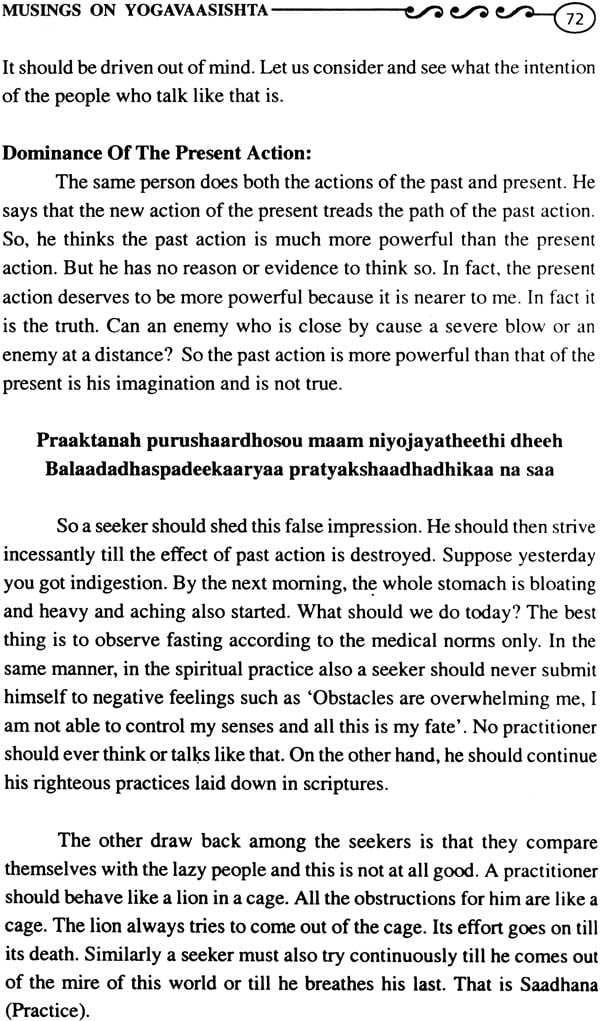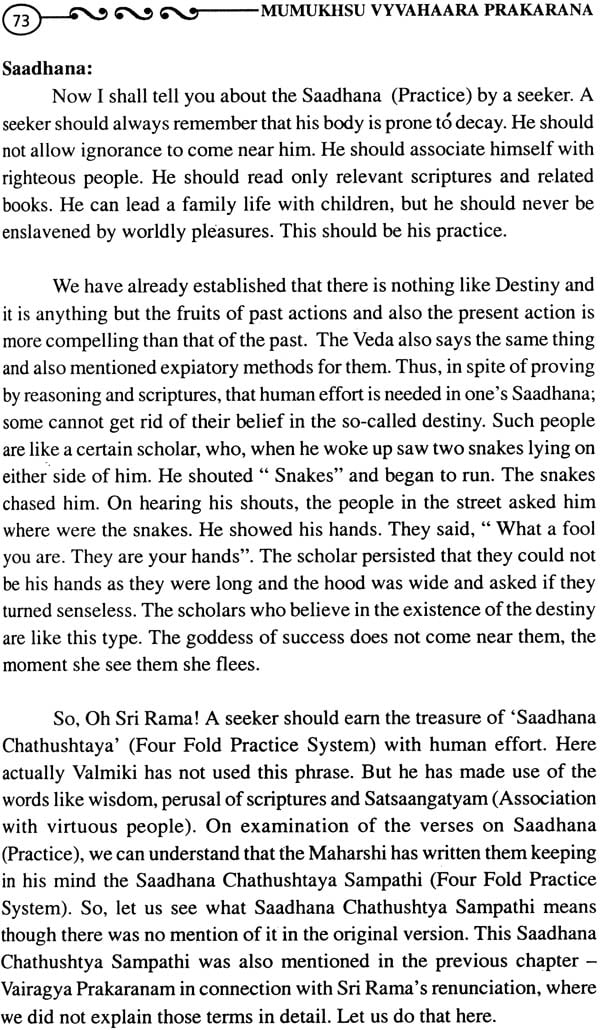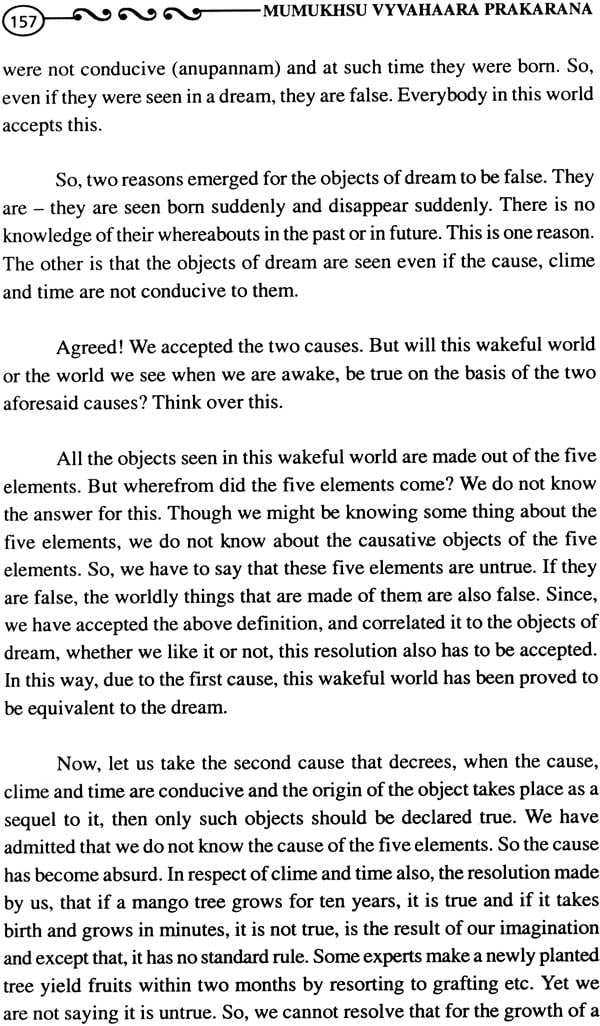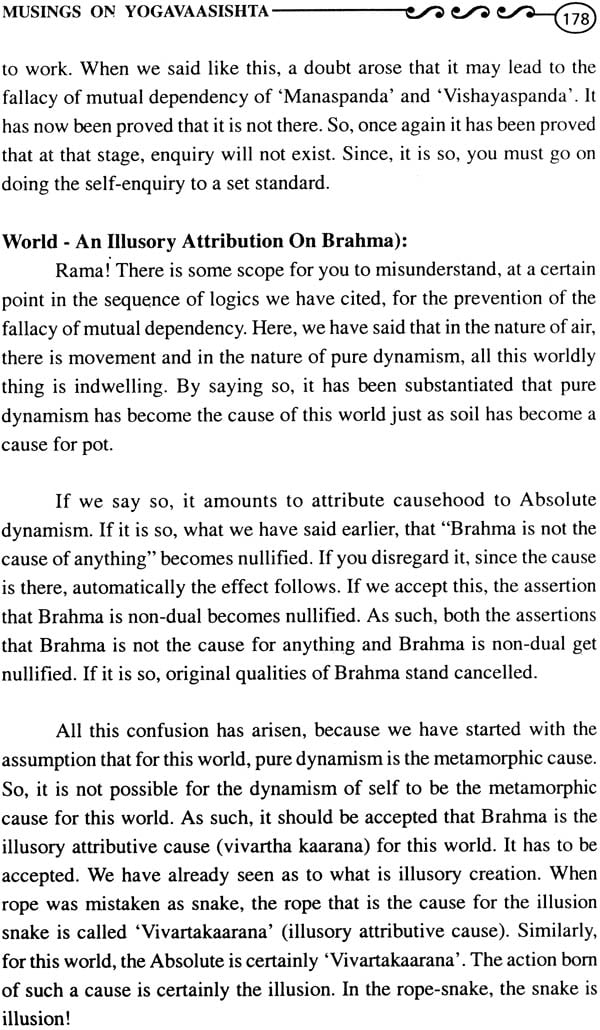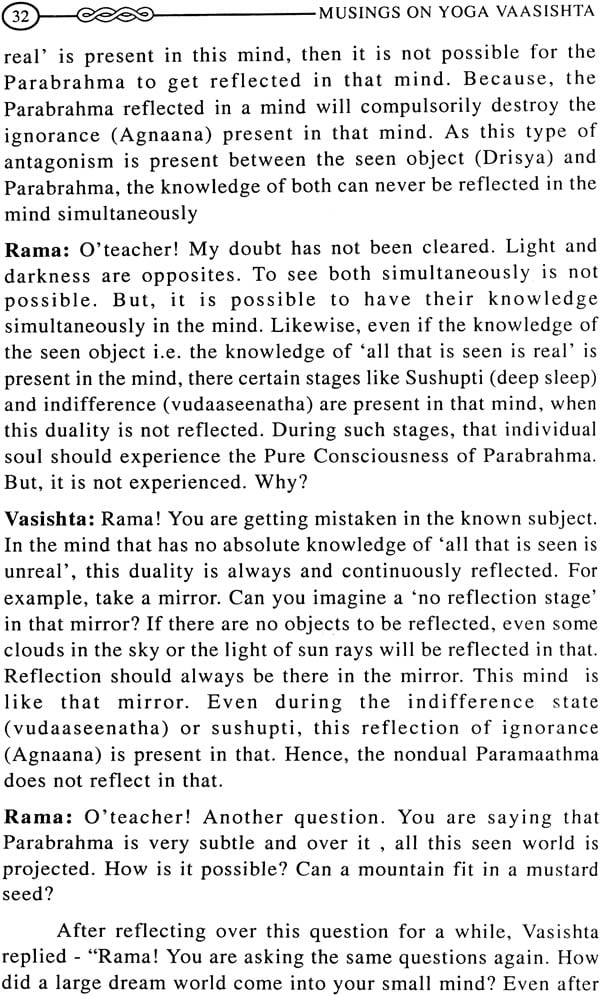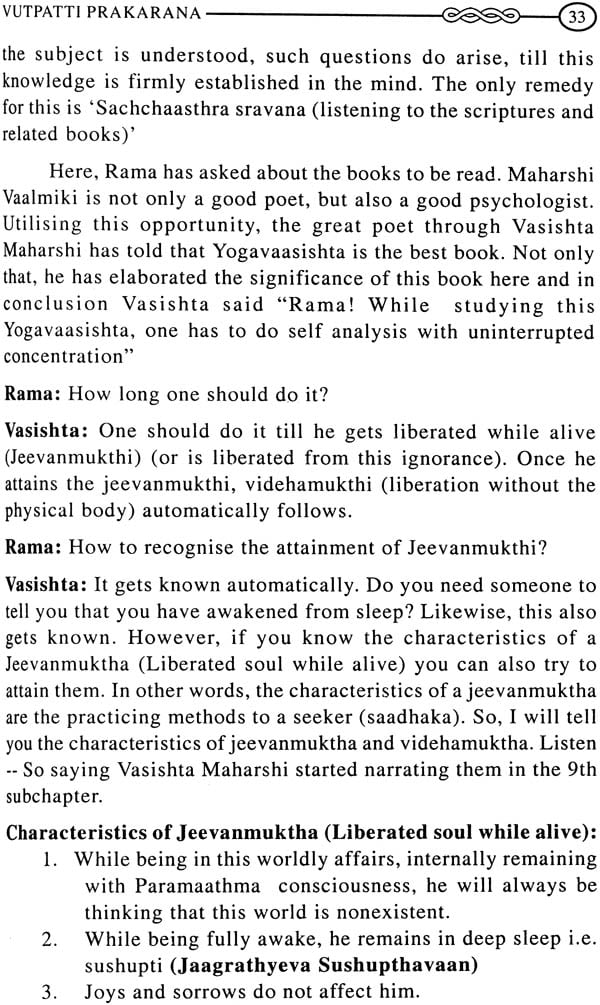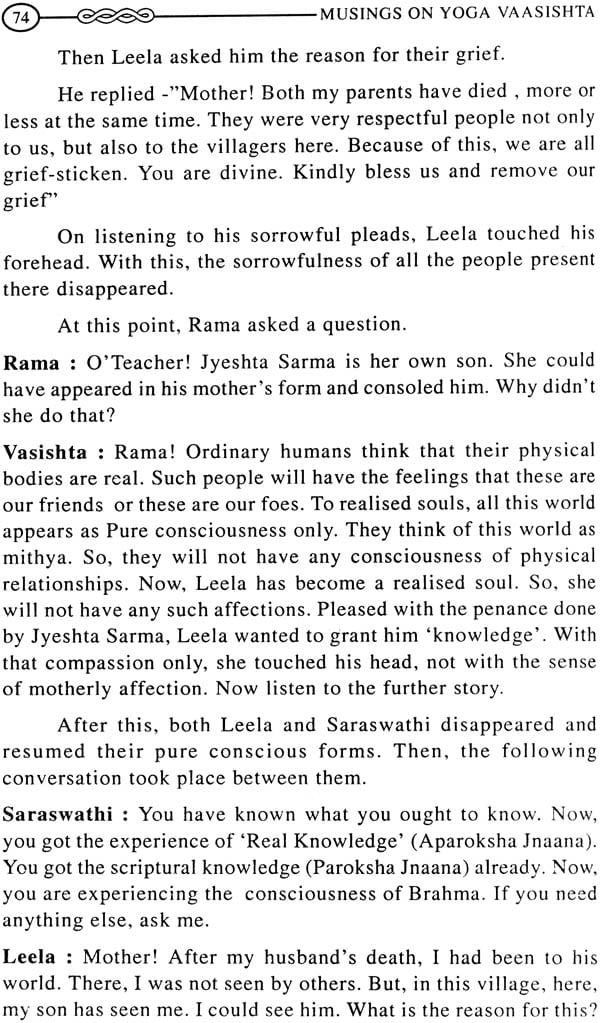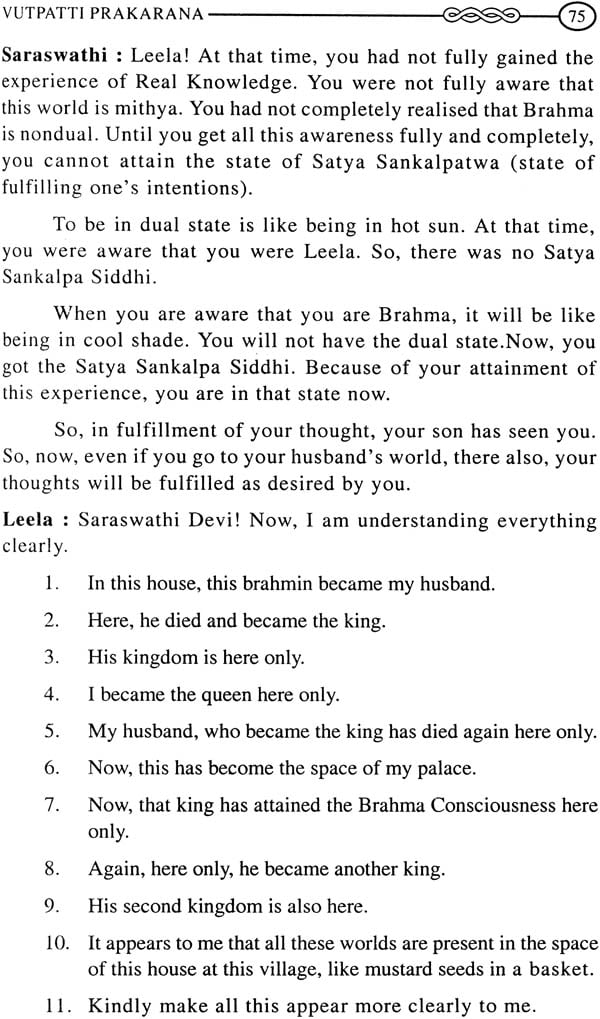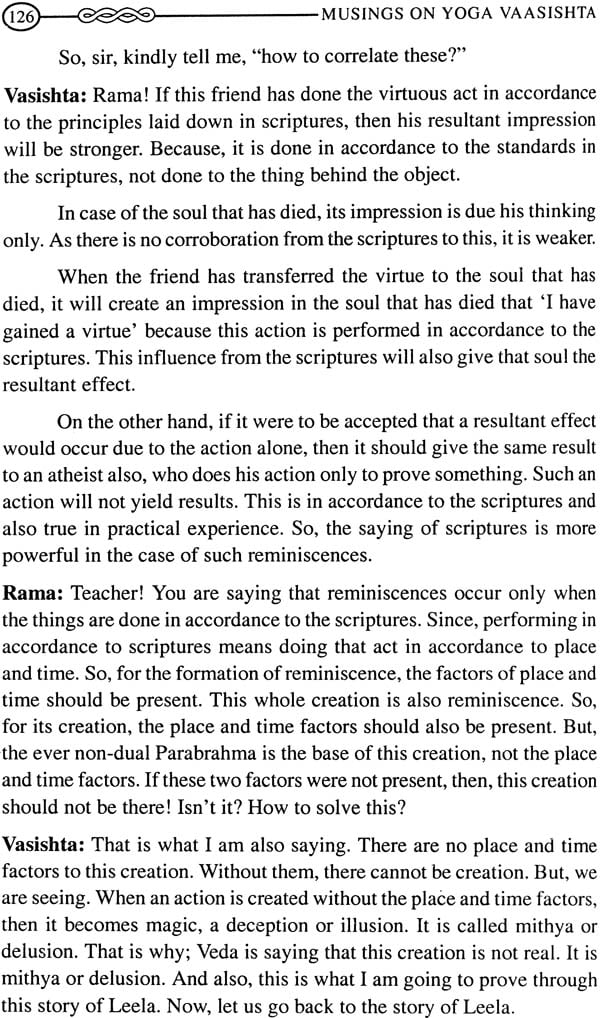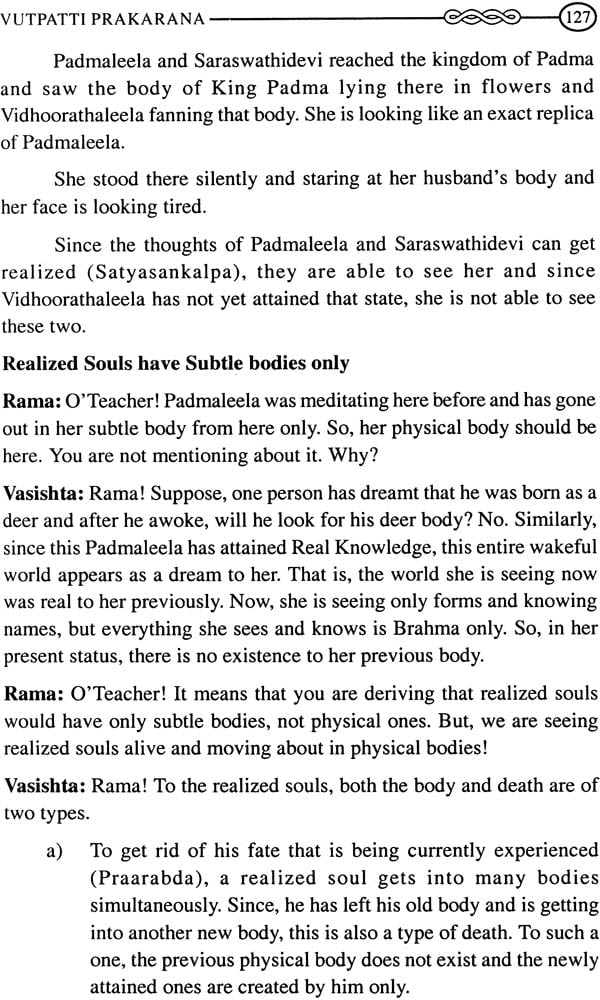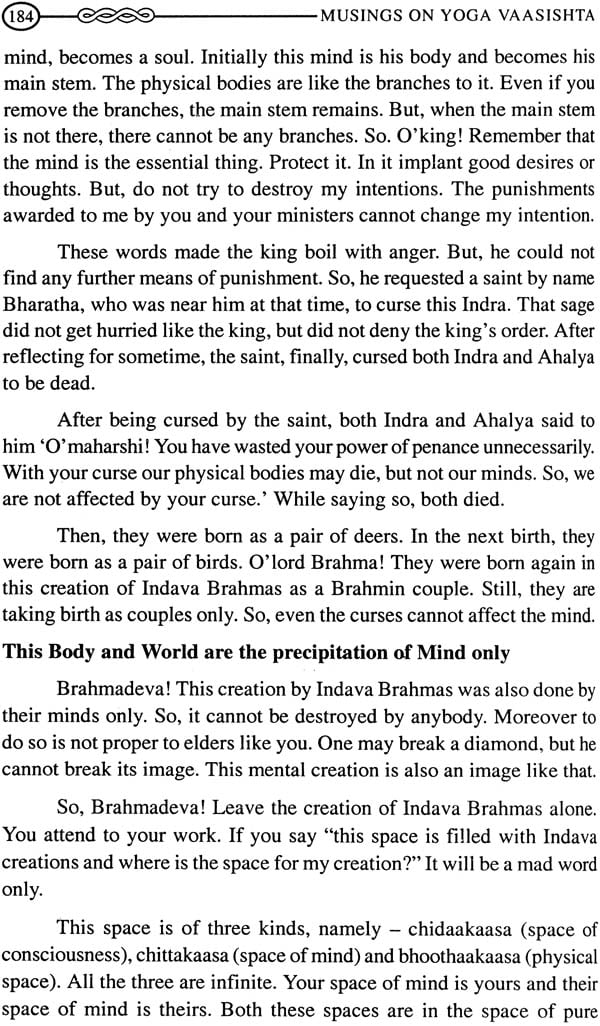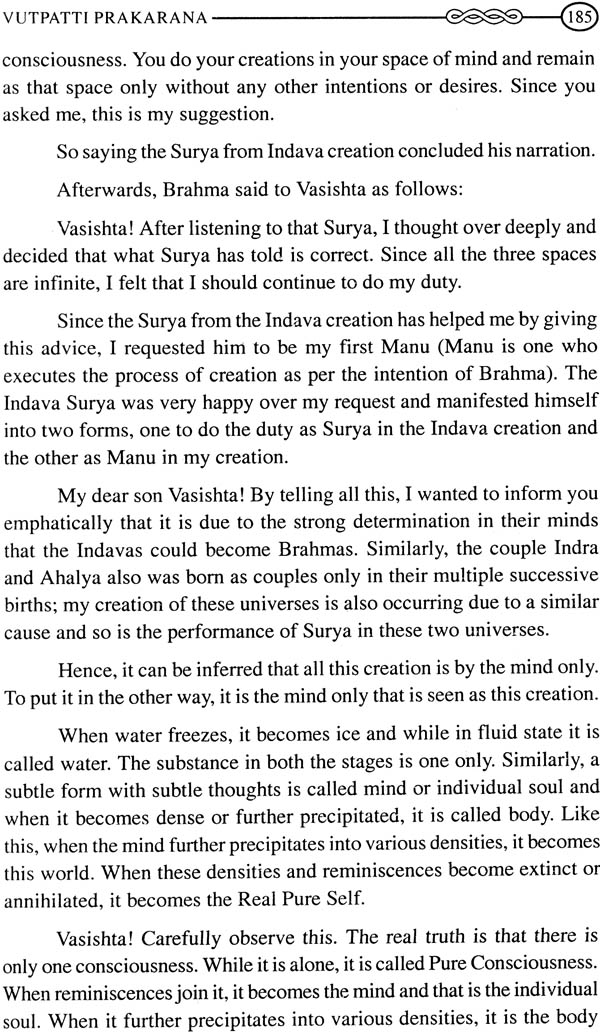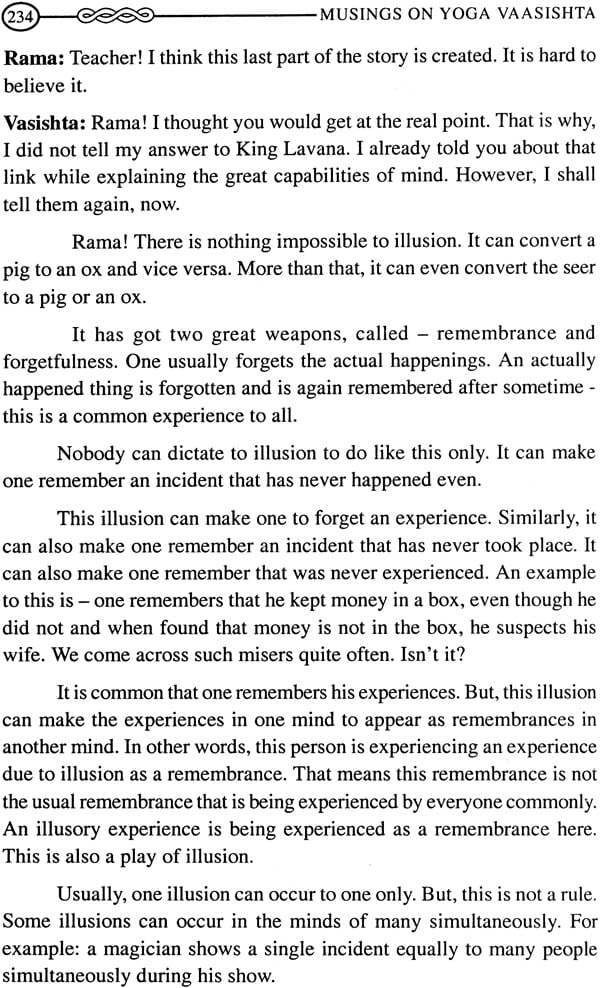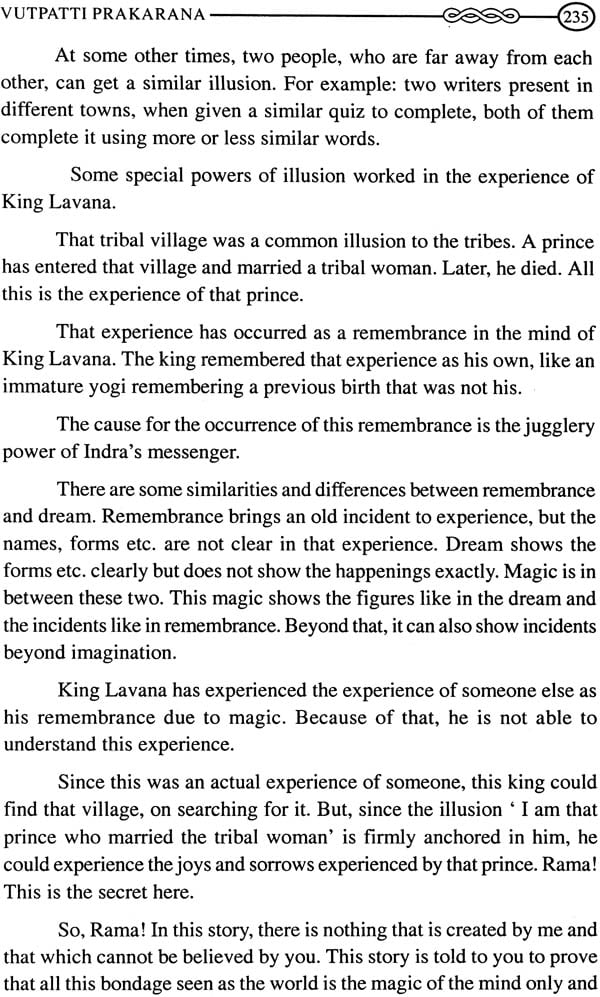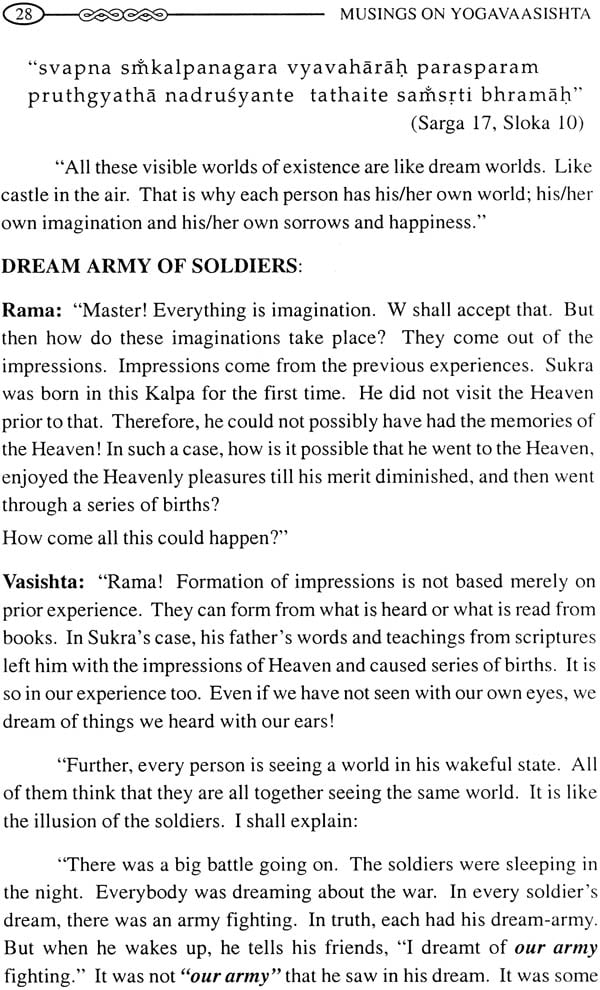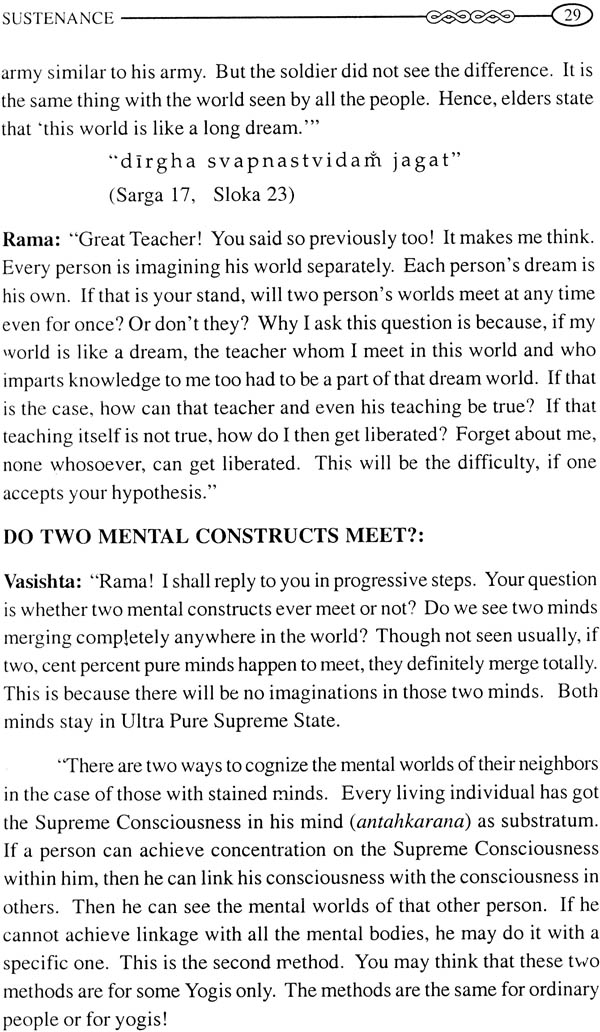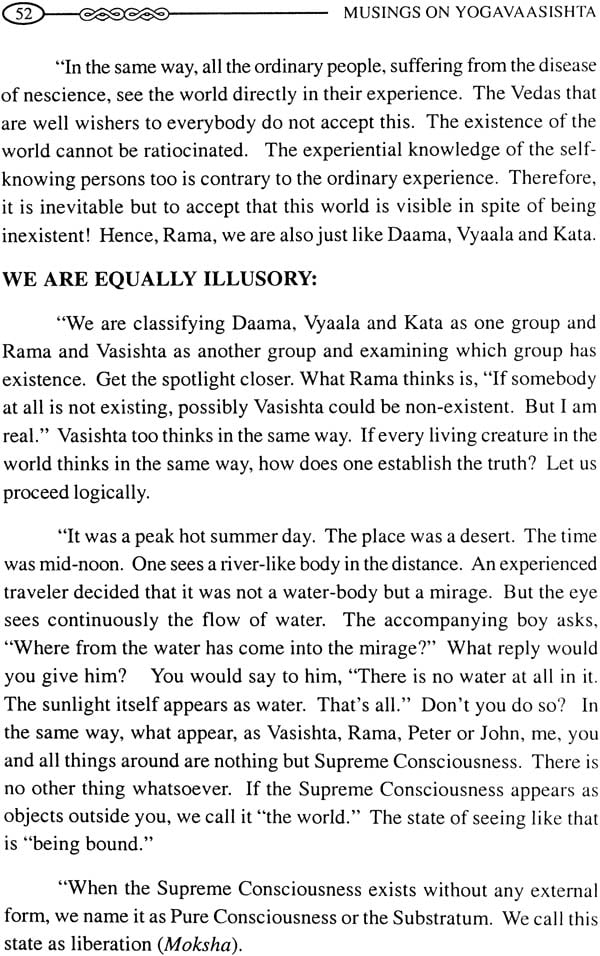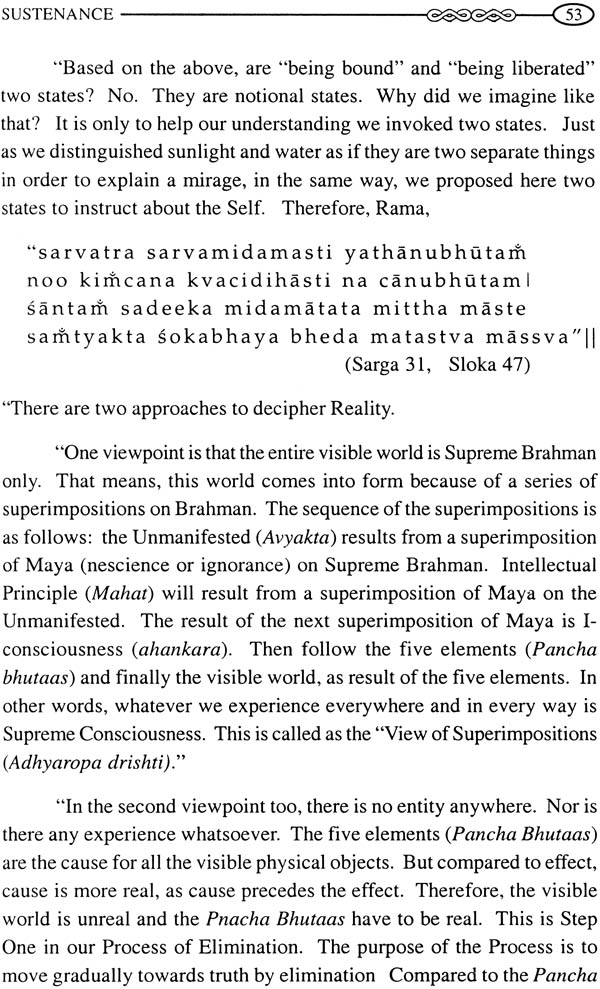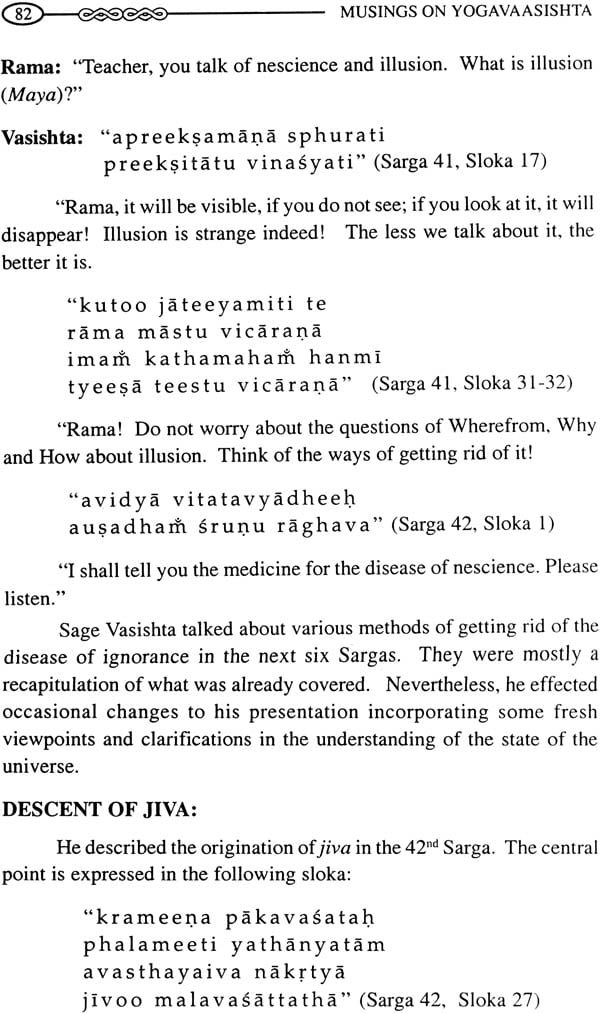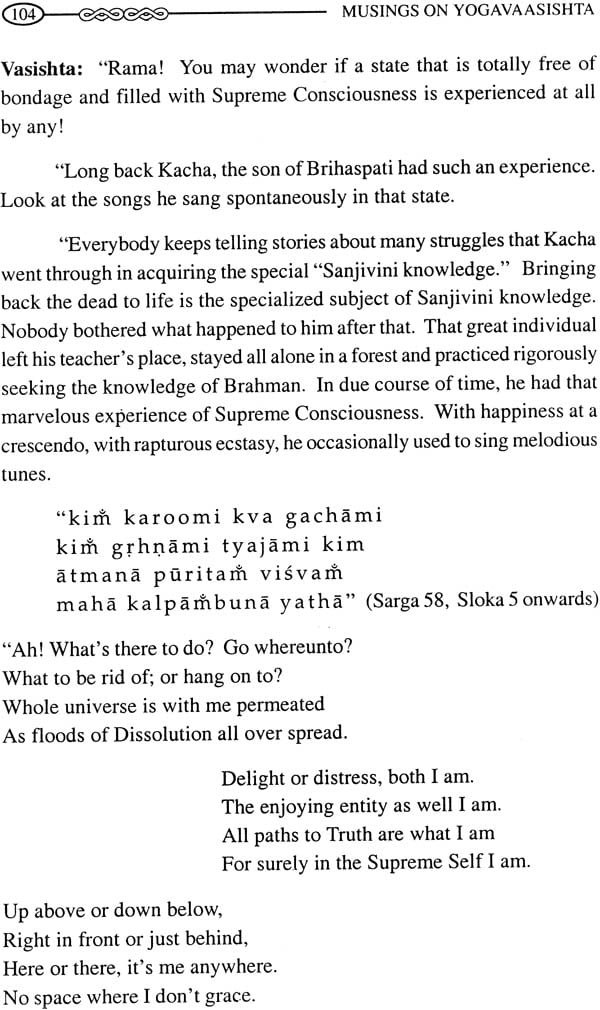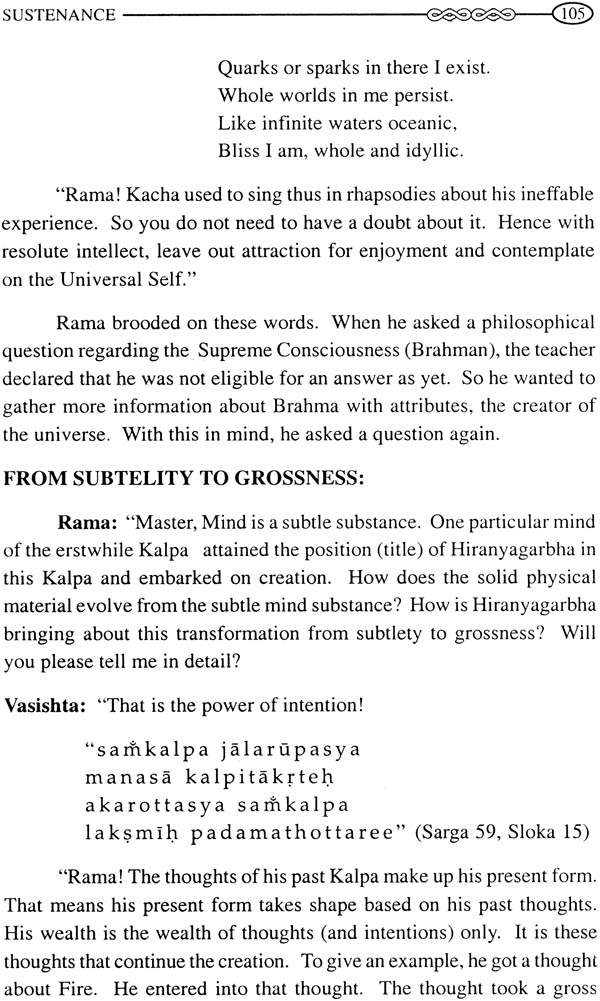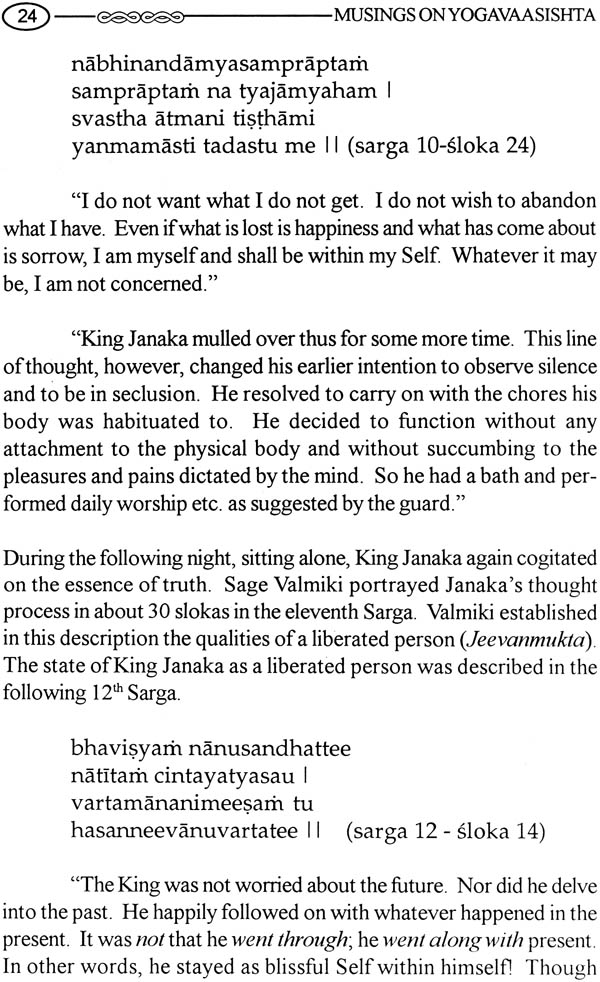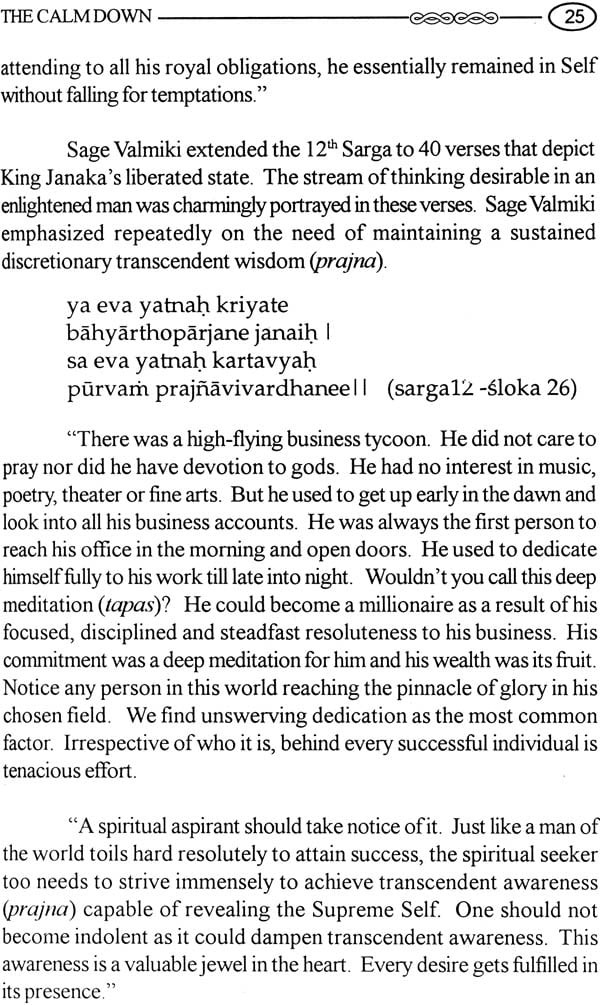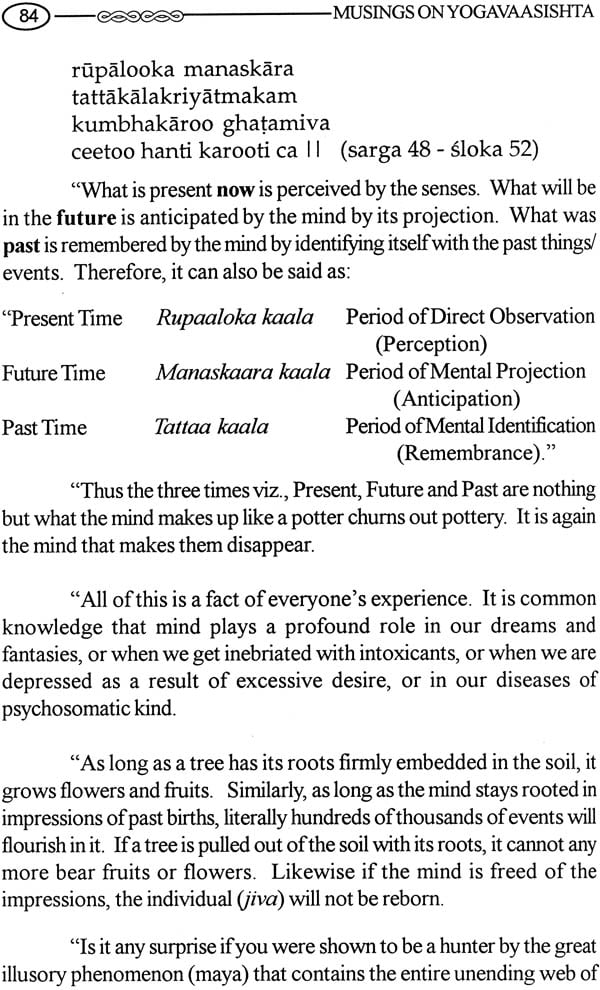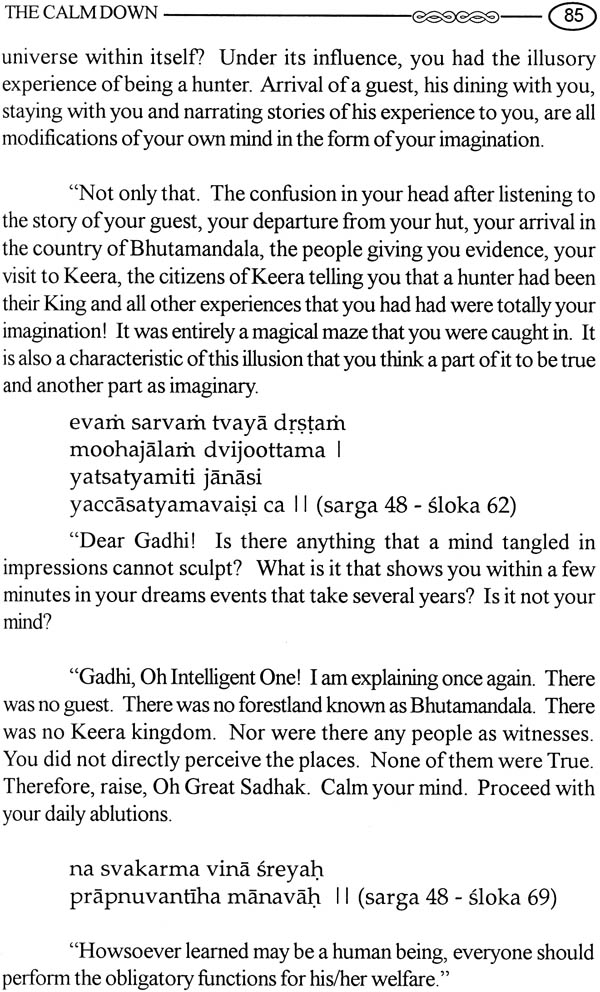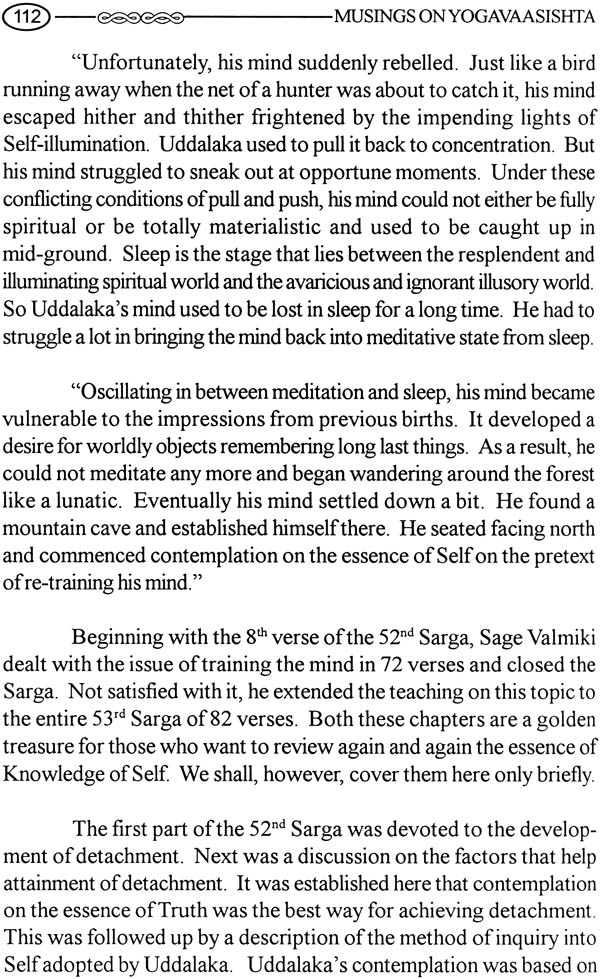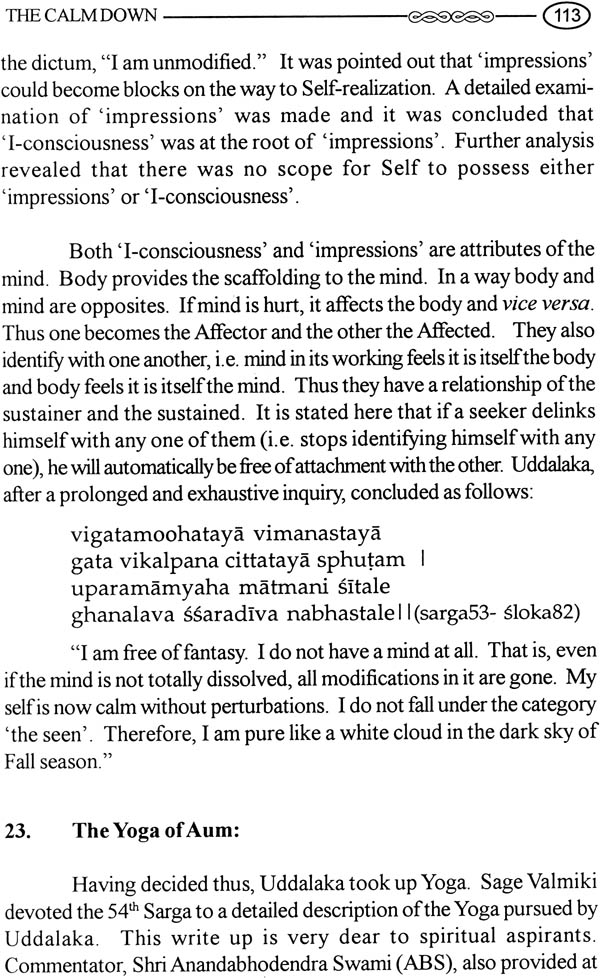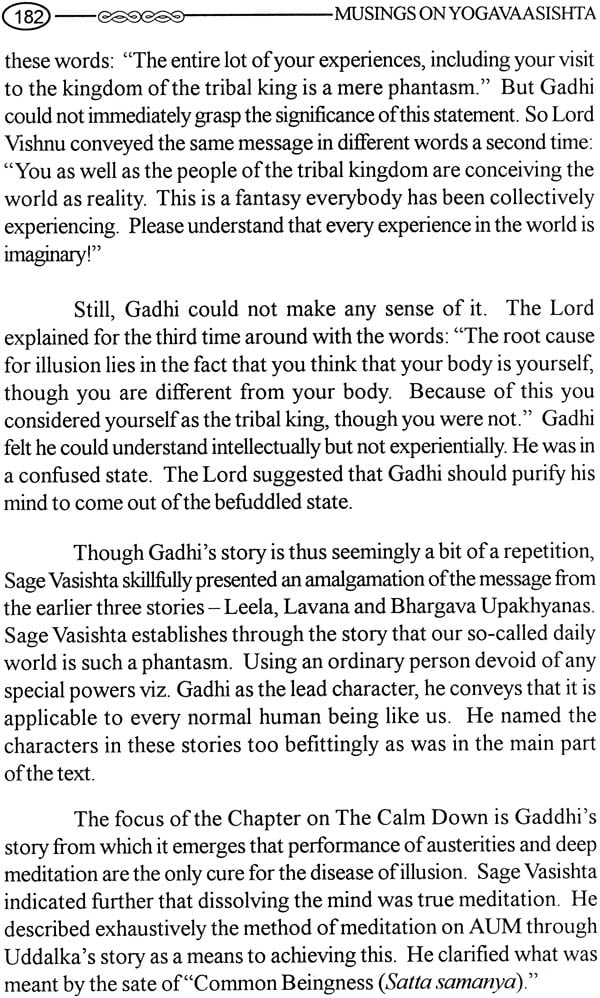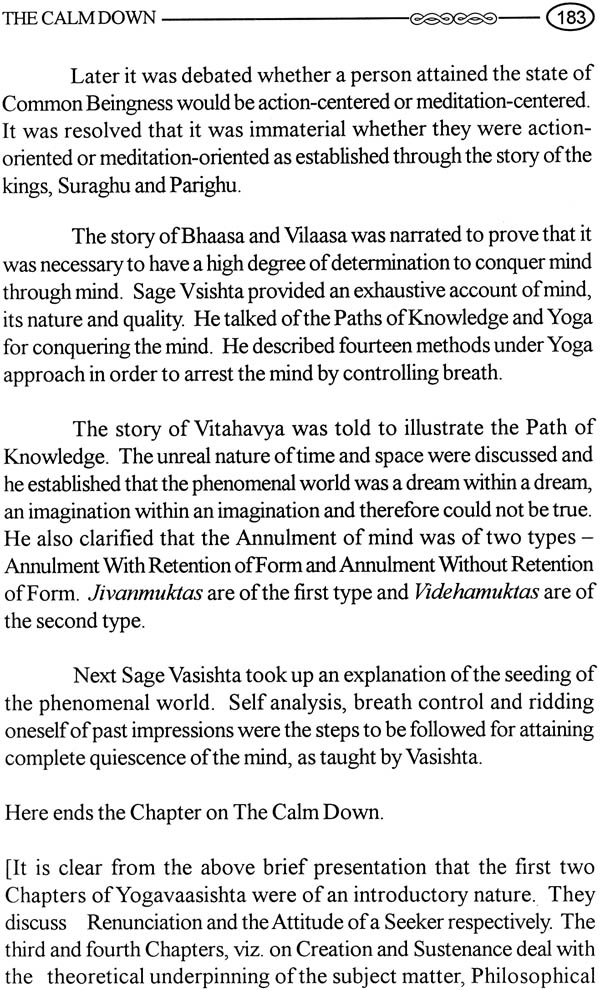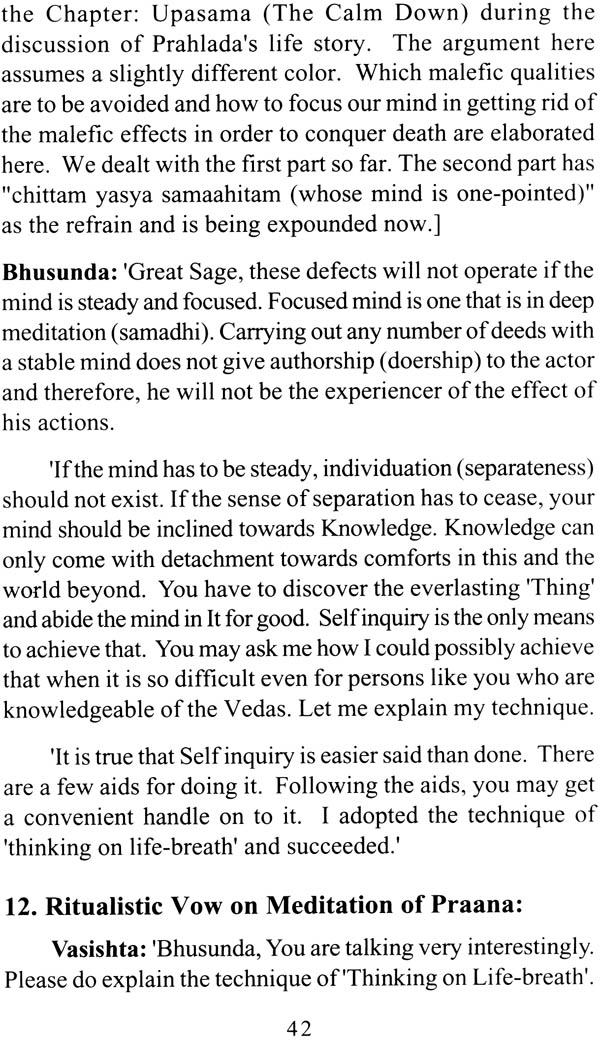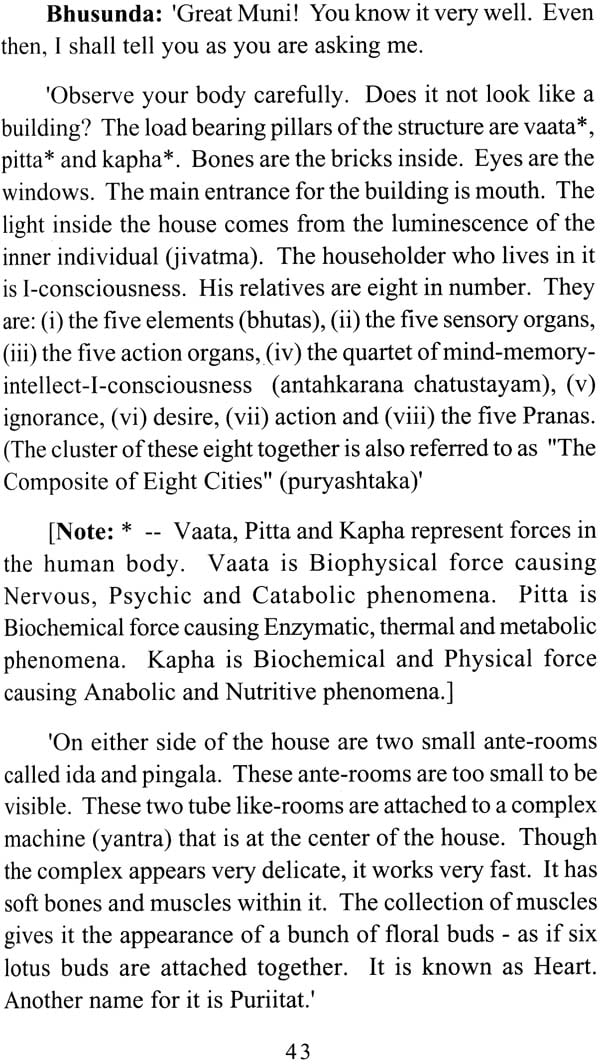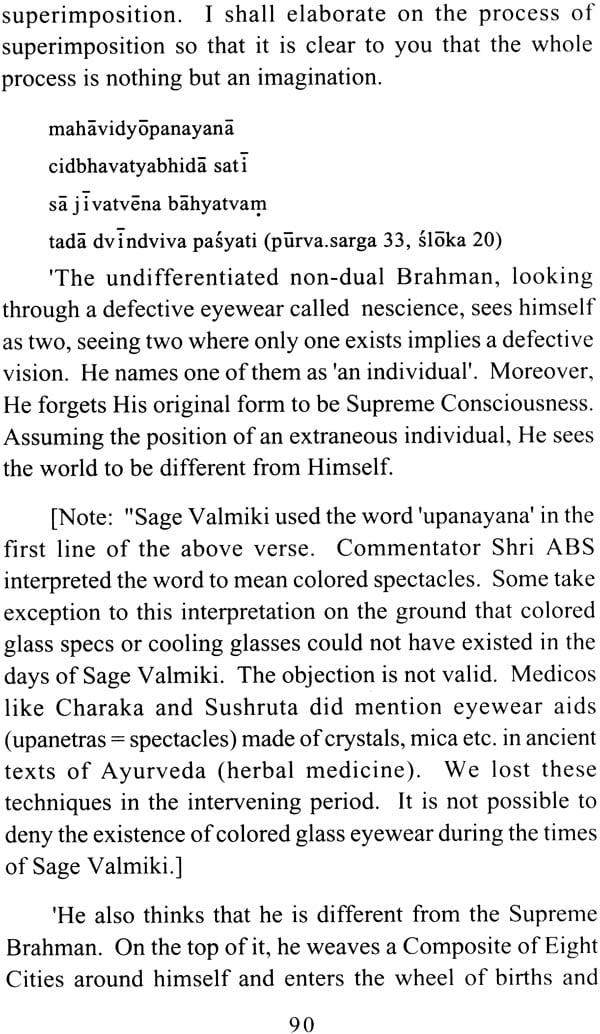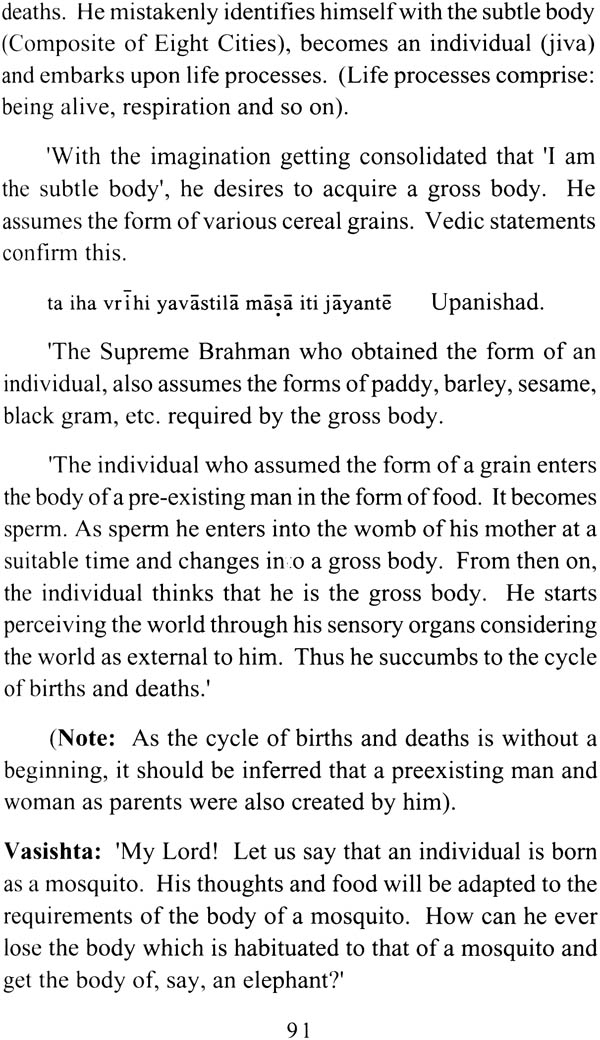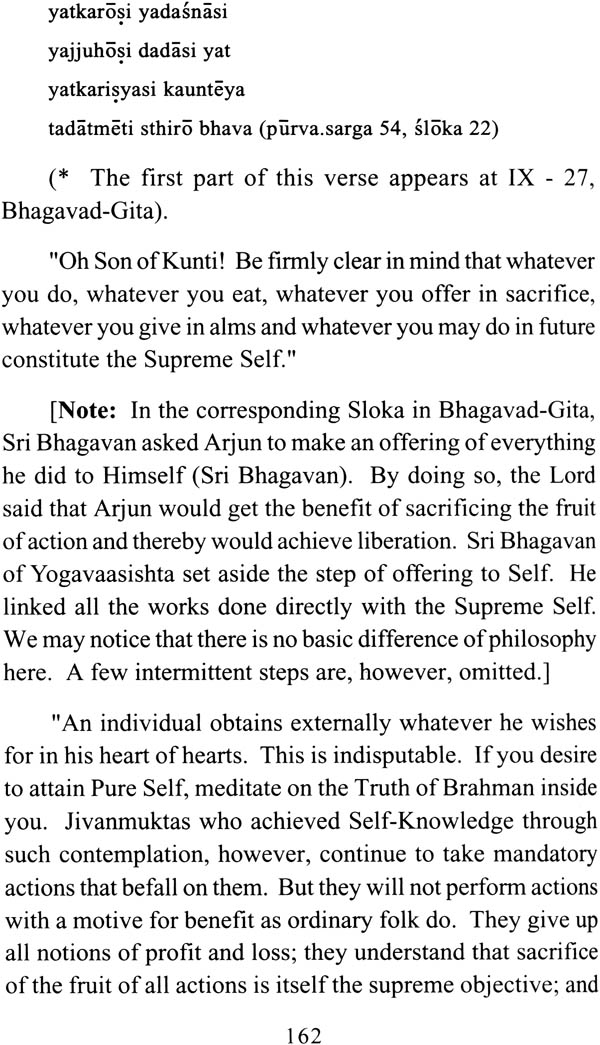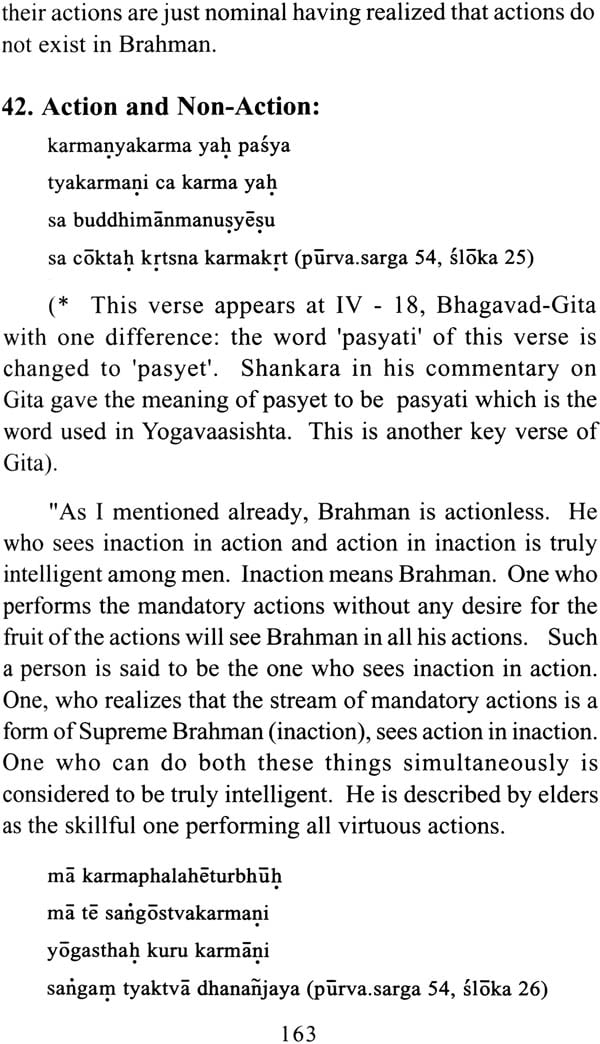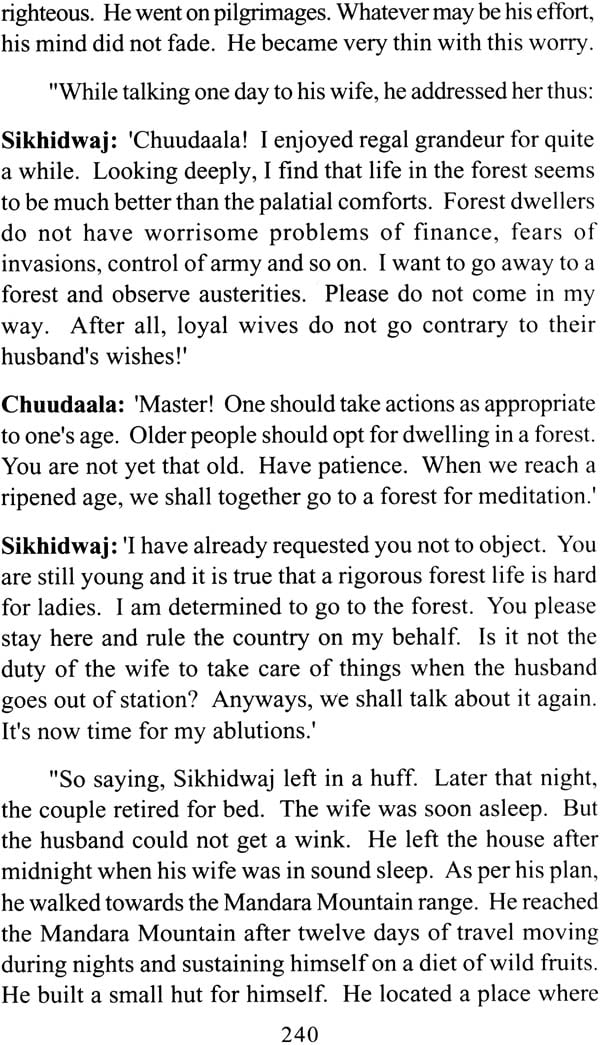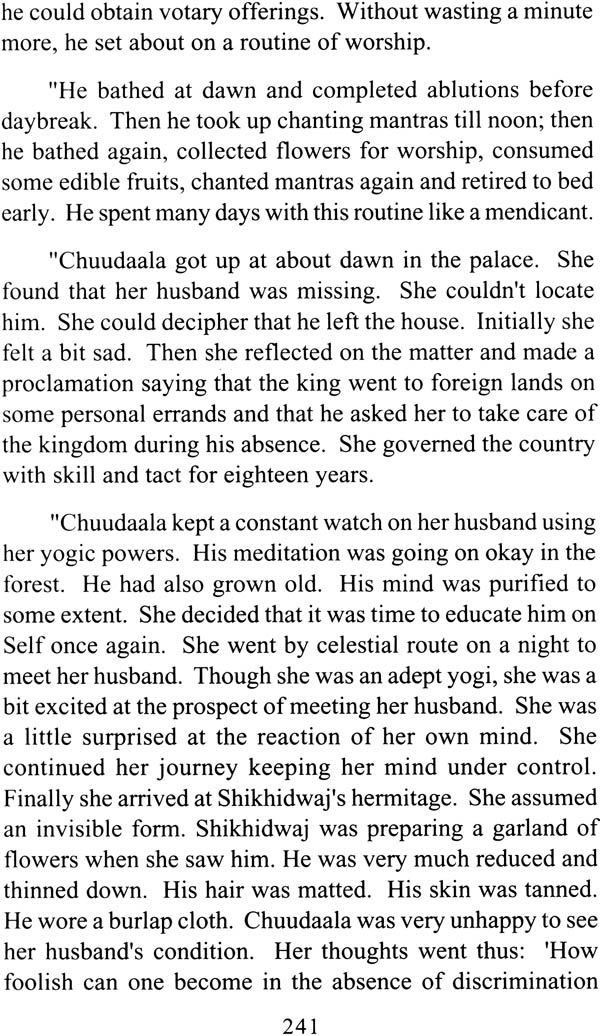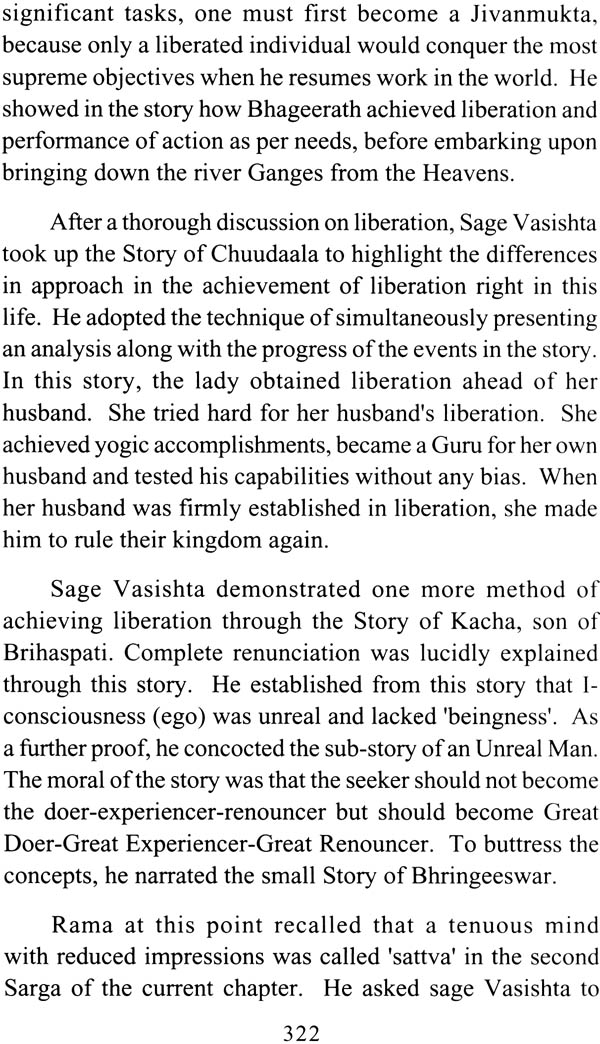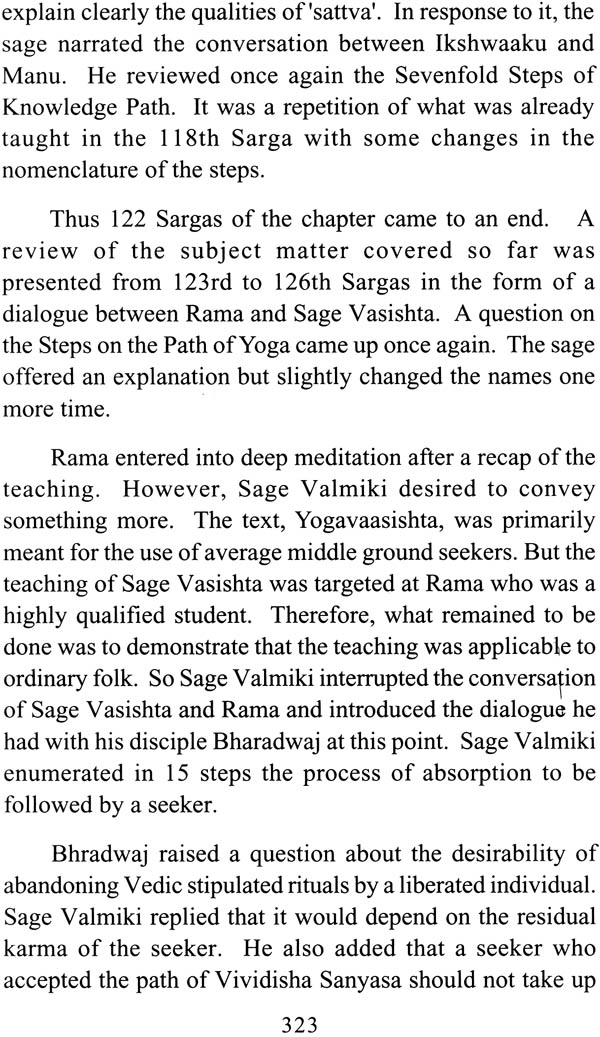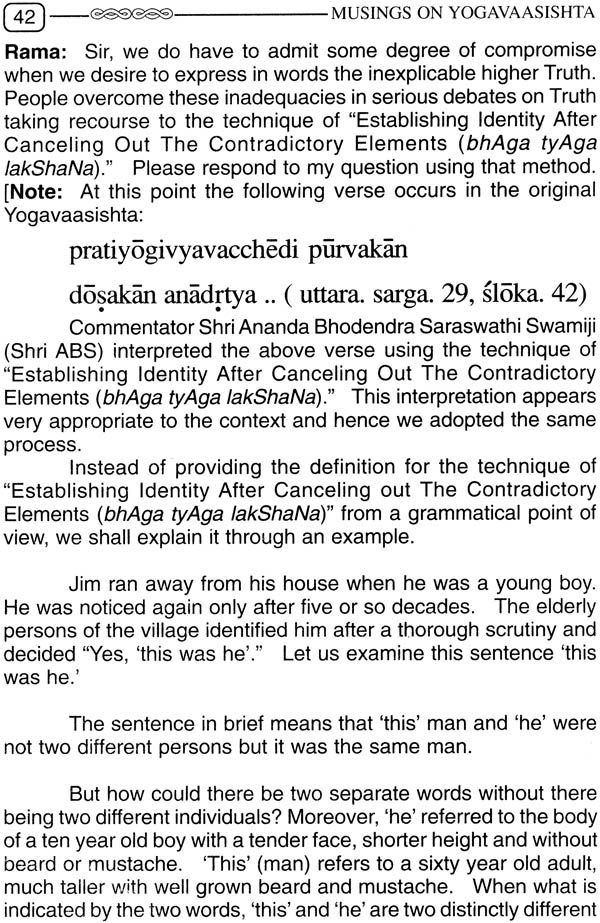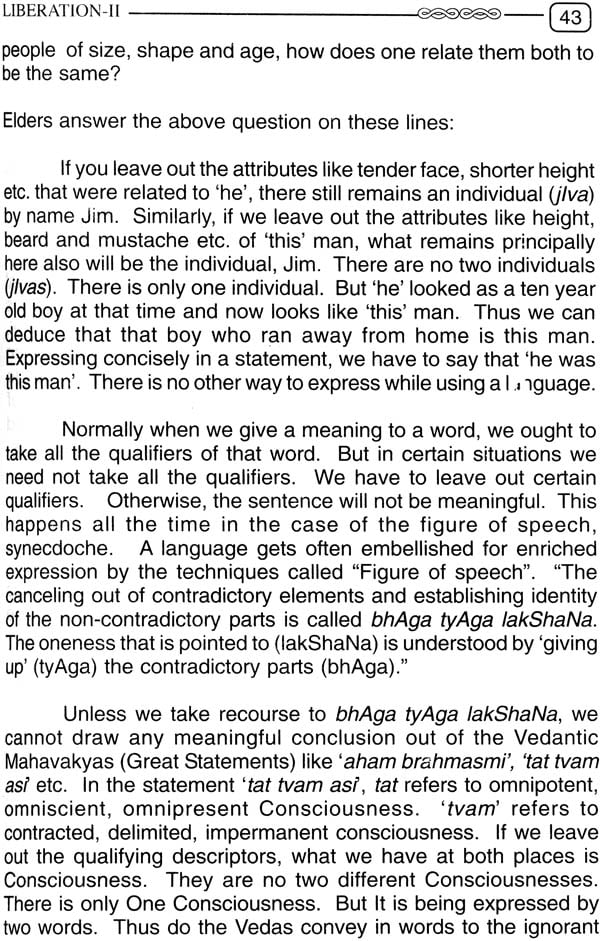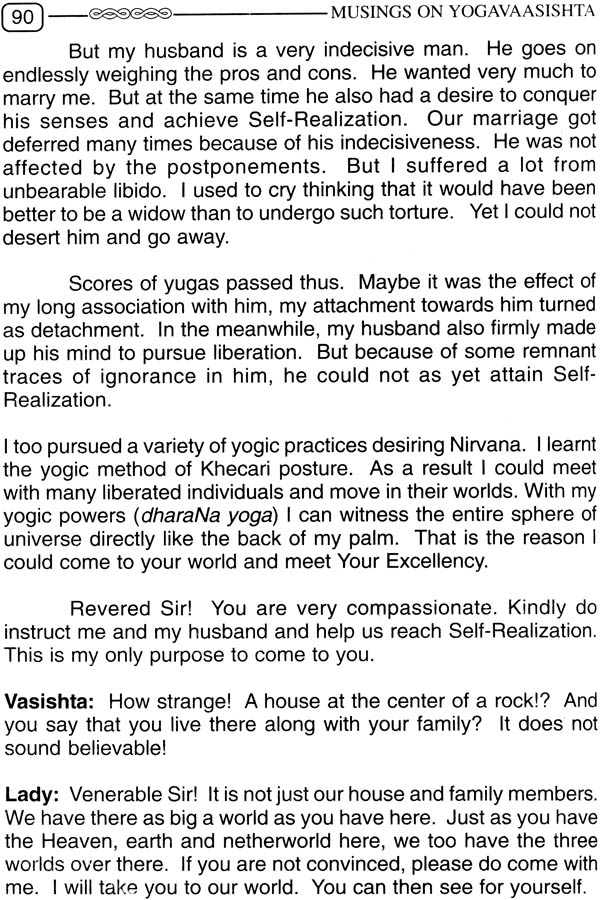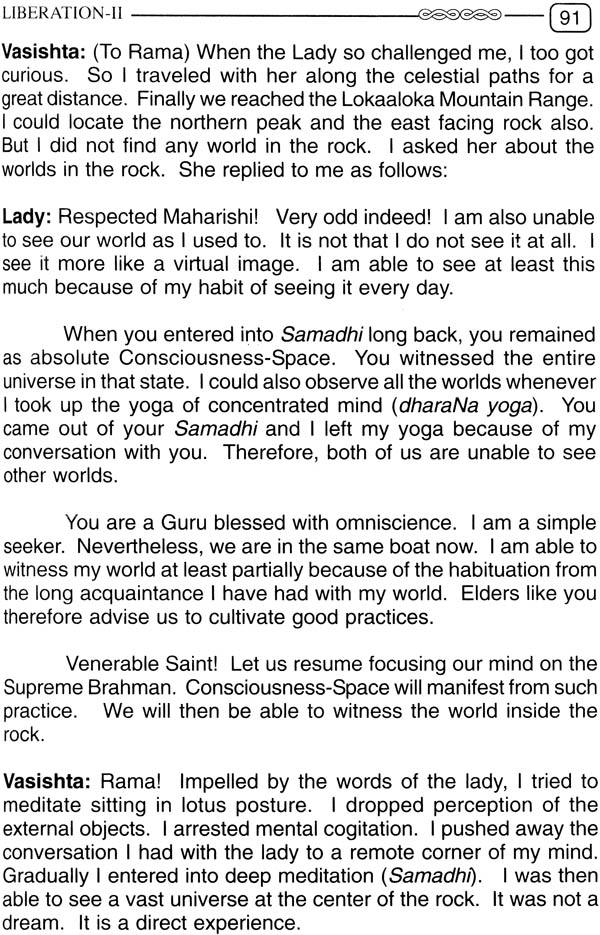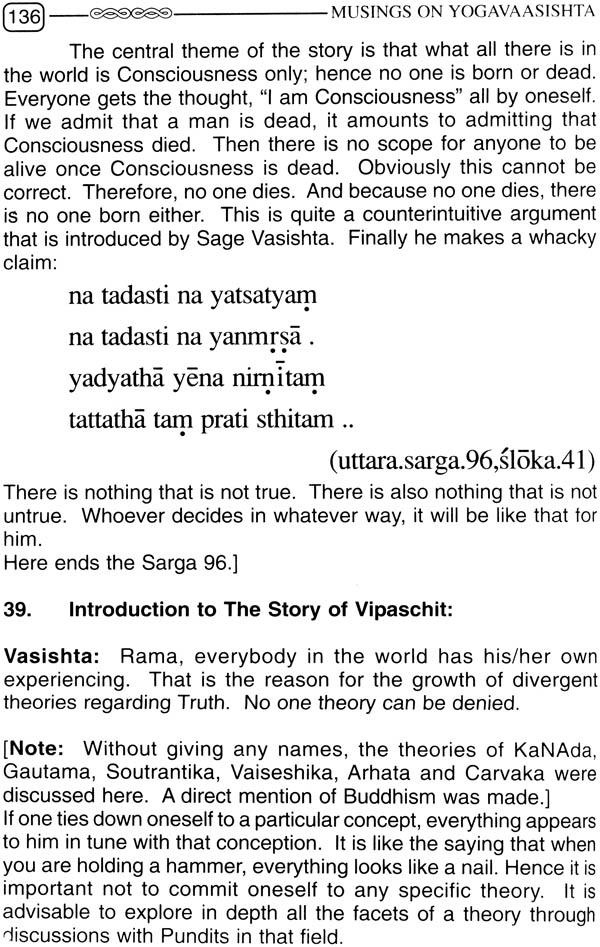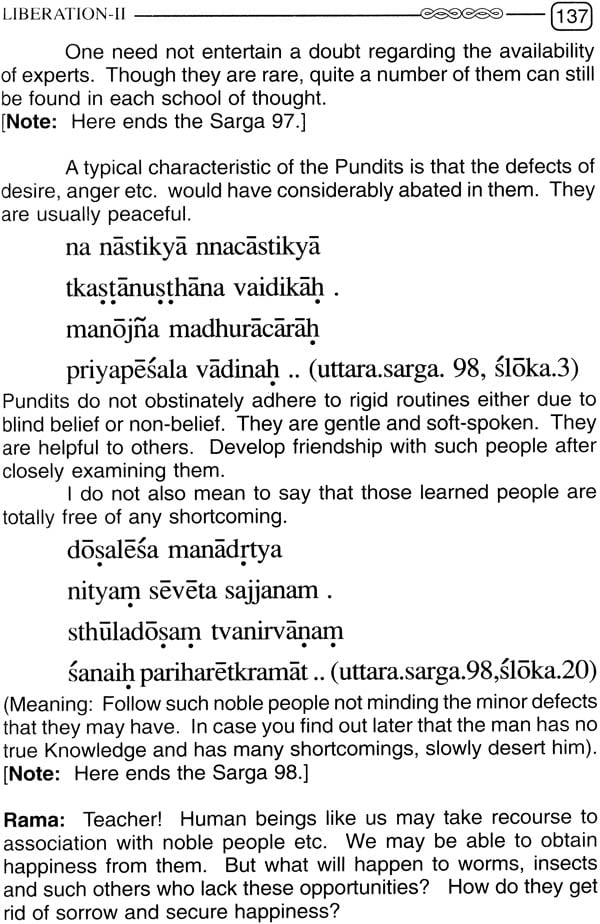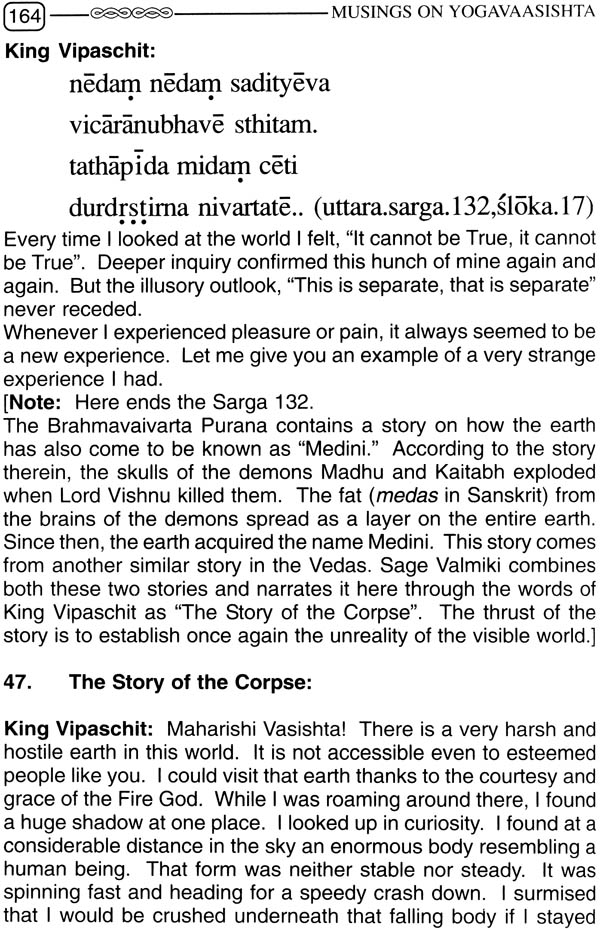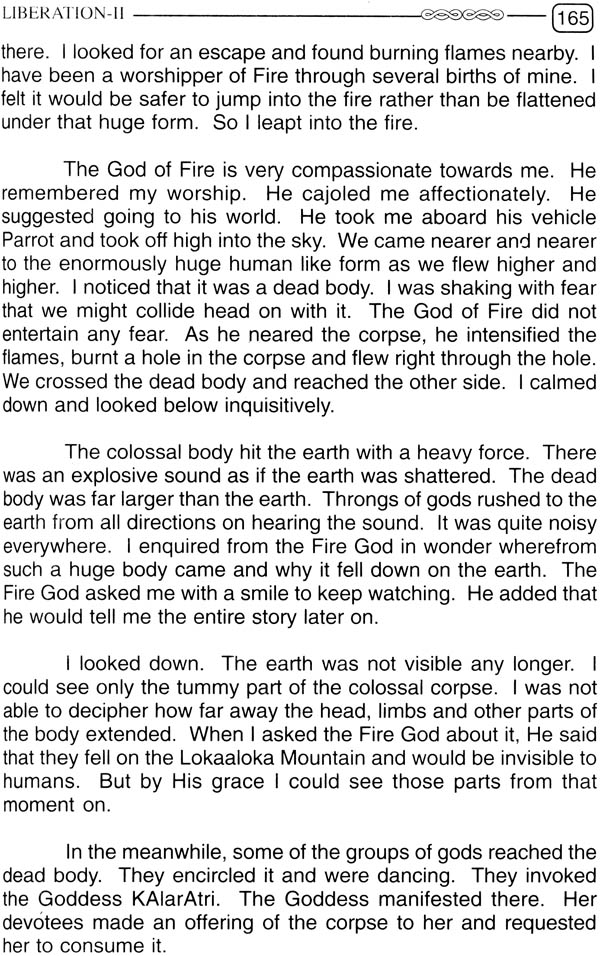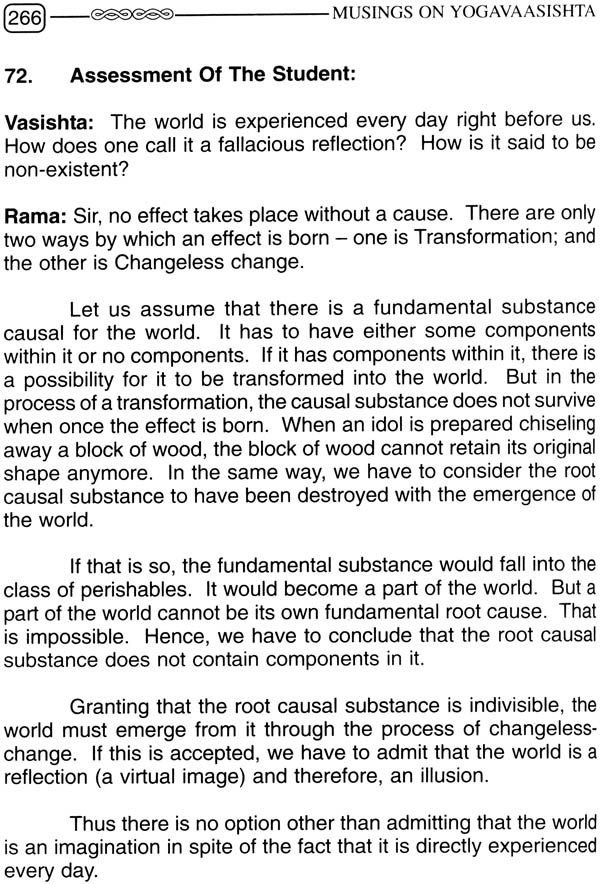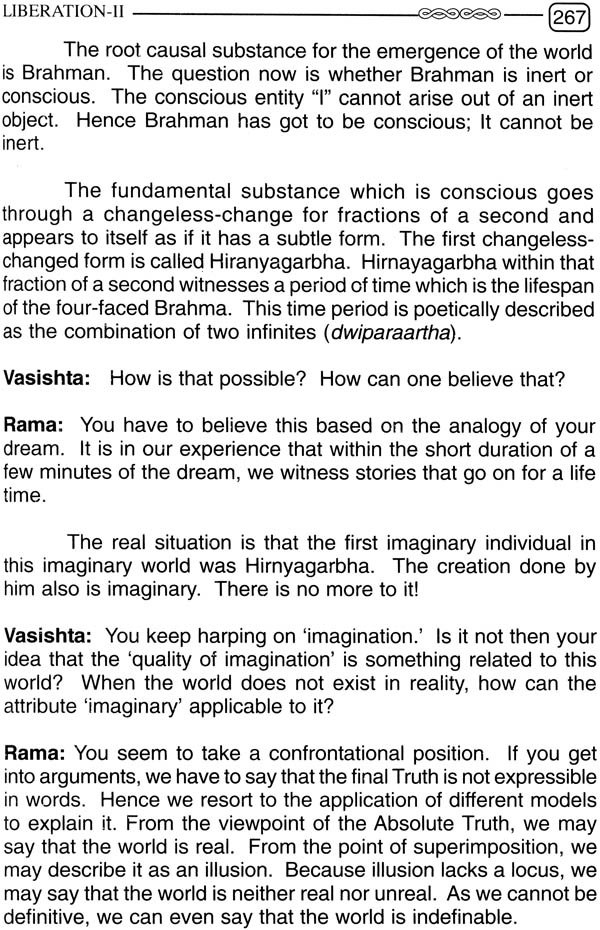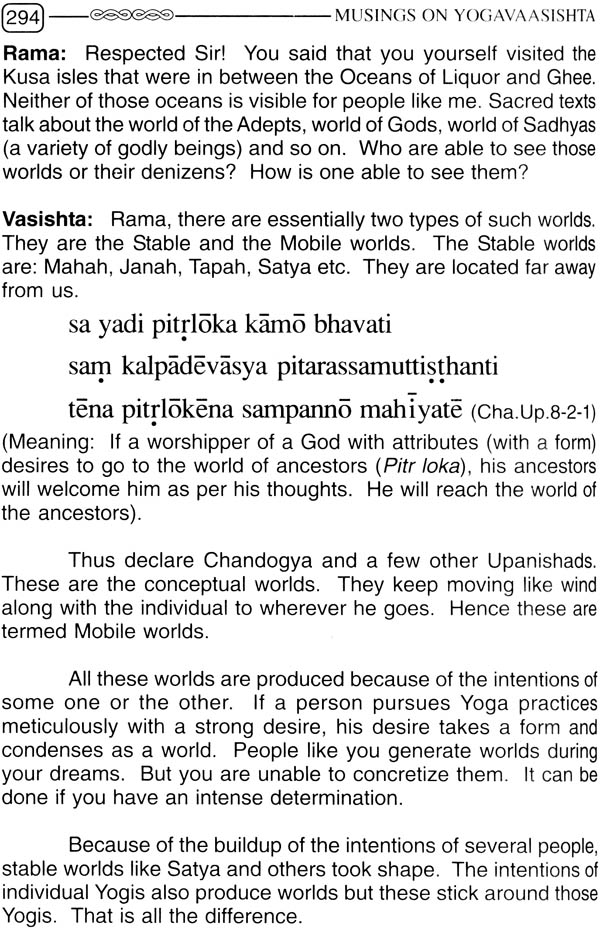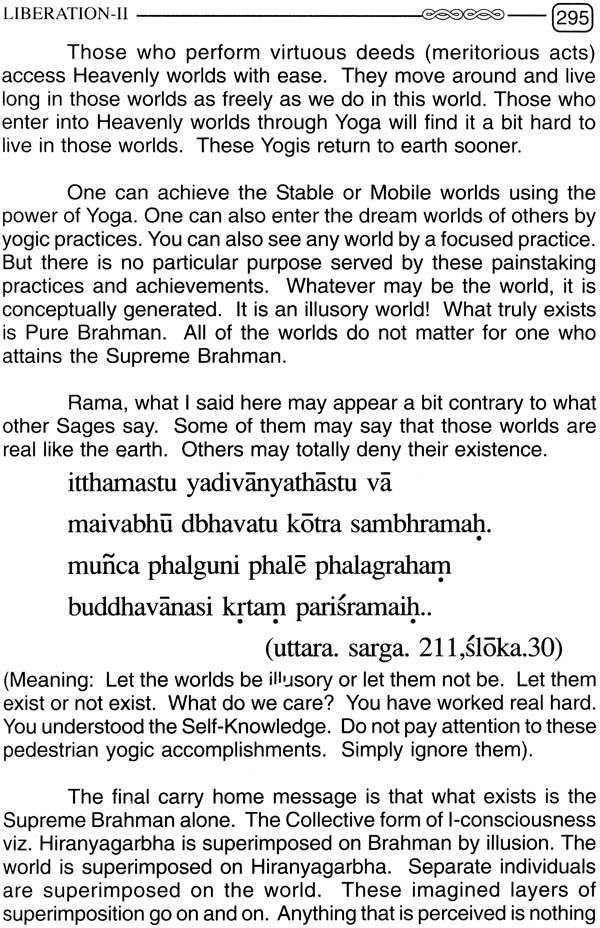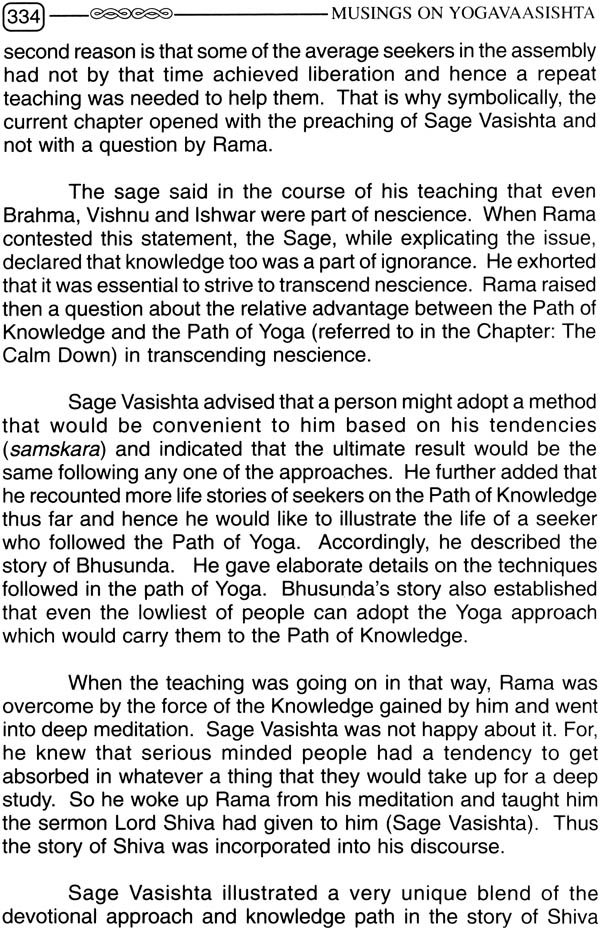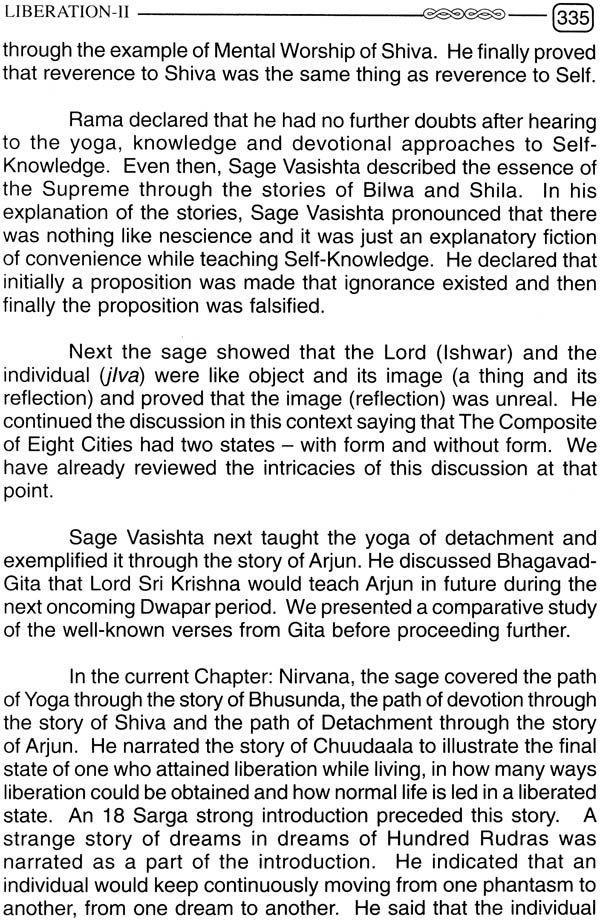
Musings on Yogavaasishta (Set of 6 Volumes) (An Old and Rare Book)
Book Specification
| Item Code: | NAK736 |
| Author: | Sri Kuppa Venkata Krishna Murthy |
| Publisher: | Avadhoota Datta Peetham, Mysore |
| Language: | Transliteration With English Translation |
| Edition: | 2010 |
| Pages: | 1577 |
| Cover: | Paperback |
| Other Details | 8.5 inch X 5.5 inch |
| Weight | 1.70 kg |
Book Description
Part-I
It is the solution given by Sage Vasishta when Sri Rama Was caught in the storm of doubts regarding the ultimate nature of Supreme-self.
It is the solution in the form of logical deductions and practical observations for a better understanding of the nature Supreme-self.
It is a correlation of apparently divergent references of Upanishads.
It is a poetic classic but allegorically explains the Absolute and presented in his unique, graceful way by the sage poet Valmiki.
It is a presentation from Brahmasri Kuppa Venkata Krishna Murthy, the Vidyaadhikari of Avadhoota Datta Peetham, Mysore in the form of his “Musings of Yogavaasishta” – a treatise of comparisons and correlations of the ancient traditional knowledge and the modern scientific knowledge, through his lectures in the Gemini-T.V. On “Yogavaasistha”.
What am I but a small twig of a mighty tree of spiritual mission of a great Sadgurudev Sri Ganapathi Sachchidananda Swamiji of Avadhuta Datta Peetham, Mysore, India. In this exercise of English Translation of a soul-stirring classic, Yoga Vasishta with its unalloyed essence in Telugu shaped forth in the hands of an unostentatious scholar Sri Kuppa Venkata Krishna Murthy, Educational Officer, Datta Peetham Mysore.
All the same, I deem it a rare opportunity for contributing my small bit thus in the Maha Yagna of knowledge undertaken by the writer, Sri Kuppa Krishna Murthy. It is indeed a pleasant coincidence that Sri Kuppa Krishna Murthy should think of bringing out his Gemini TV discourses on Yogavasishta in the book from in Telugu first with the encouragement of the Neuland Labs Chief, Dr. R. Rao and his wife Mrs. Vijaya, staunch devotees of Sri Swamiji and subsequently meet the wish of Sri Swamiji to get it translated into English. The choice of me both by the writer and the sponsorer for translation also perhaps met with the ‘samkalpa’ of Sri Swaniji.
My humble obeisance to Sri Swamiji for making me an instrument again in this service, In the series of Sri Guru Gita’. ‘Jnaana Sagar’ and ‘Katha saagar’ volume in English.
I, now offer my gratitude to Sri Kuppa Venkata Krishna Murthy and Dr. Rao for trusting me to fulfilling their expectations before entrusting me with the task.
I would fail in my duty if I do not acknowledge Sri A.V. Sarma’s ungrudging help in correcting the proofs in respect of the aforesaid translations time and again. I also thank Mr. S. Nagaraj of Neuland Labs for computerizing the matter in parts even as Mr. Y. Bhaskar, Lecturer in Computer Science, Progressive Degree College, Hyderabad.
| Writer's Appeal | i | |
| Translator's Note | xi | |
| I | Vairaagya Prakarana | 1-36 |
| 1 | Origin of the book | 2 |
| 2 | Who is eligible to read Yogavaasishtam? | 5 |
| 3 | Story of Arishtanemi | 6 |
| 4 | Agnivesya - Karunyakumar | 8 |
| 5 | Significance of the book | 9 |
| 6 | Sutheekshna | 10 |
| 7 | Correlation of Karma - Jnana | 11 |
| 8 | Curses of Srihari | 13 |
| 9 | Detachment of Sri Rama | 16 |
| 10 | Classification of Yogavaasishta | 21 |
| 11 | What is Vairaagya? | 22 |
| 12 | Sane Inquiry | 23 |
| 13 | Wealth | 24 |
| 14 | Longevity | 24 |
| 15 | Ego | 25 |
| 16 | Mind | 27 |
| 17 | Trishna | 28 |
| 18 | Body | 29 |
| 19 | Childhood, Youth & Old age | 30 |
| 20 | Time | 32 |
| 21 | Looking at the faults | 33 |
| 22 | Congratulation of Maharshis | 34 |
| II | Mumukhsu Vyvahaara Prakarana | 37-182 |
| 1 | History of Shuka | 37 |
| 2 | Yukti Vicharana | 39 |
| 3 | Analysis of Vedic saying | 46 |
| 4 | Preaching of Kind Janaka | 49 |
| 5 | Viswamitra's preaching | 51 |
| 6 | Vasishta's preaching | 55 |
| 7 | Three Spaces | 56 |
| 8 | What is Subtle? | 57 |
| 9 | Sky is also a matter | 58 |
| 10 | Pervas ive ness | 58 |
| 11 | Chidaakaasam | 59 |
| 12 | Manorajyam | 59 |
| 13 | How the birth take place? | 60 |
| 14 | Sequence of Vyasa's birth | 61 |
| 15 | What is Kalpa? | 61 |
| 16 | Liberation while alive | 62 |
| 17 | Personalities bestowed with authority | 64 |
| 18 | Attainment of Liberation | 65 |
| 19 | Plan of Preaching | 66 |
| 20 | Human Efforts | 68 |
| 21 | Destiny is Action | 69 |
| 22 | Types of Human Efforts | 70 |
| 23 | Past Action & Present Action | 71 |
| 24 | Dominance of the Present Action | 72 |
| 25 | Saadhana | 73 |
| 26 | Saadhana Chathushtaya | 74 |
| 27 | Three Contrivances | 82 |
| 28 | Laziness | 83 |
| 29 | Whether there is Destiny or not? | 84 |
| 30 | The Trio of Movements | 88 |
| 31 | Destiny: A Word of Solace | 91 |
| 32 | Is Destiny The Doer? or Instrument? | 92 |
| 33 | Destiny is like the sky | 94 |
| 34 | Why abuse destiny? | 96 |
| 35 | Beings have some amount of freedom | 97 |
| 36 | How to prevent bad Samskaaras? | 98 |
| 37 | Can the Antharyaami be the motivator? | 99 |
| 38 | What is Independence? | 101 |
| 39 | What is Action? | 102 |
| 40 | Who is a Doer? | 103 |
| 41 | God is independent? | 104 |
| 42 | You yourself are the independent Doer | 105 |
| 43 | How to divert the Mind towards God? | 106 |
| 44 | Contemplation on good things is the solution | 108 |
| 45 | If we are wrong? | 109 |
| 46 | Joy - Bliss | 111 |
| 47 | Recapitulation of the discussion | 112 |
| 48 | Niyati | 113 |
| 49 | Initiation by Brahma | 116 |
| 50 | Creation of Vasishta | 119 |
| 51 | Evolution of the educational curriculum | 121 |
| 52 | Types of Wisdom | 123 |
| 53 | Qualities of Teacher & the Taught | 124 |
| 54 | Analysis of the True nature of self | 125 |
| 55 | Sravana, Manana & Nidhi Dhyaasa | 127 |
| 56 | Sama (Tranquility) | 129 |
| 57 | Vichaarana (Enquiry) | 132 |
| 58 | Aabhaasa Chitta | 137 |
| 59 | Santhosha | 141 |
| 60 | Size of the book | 144 |
| 61 | World in the Womb of the Atom | 146 |
| 62 | Allegory (Drishtantha) | 151 |
| 63 | Relative Allegory (Saapekshika Drishtantha) | 153 |
| 64 | Comparison bin Dream & Wakefulness? | 155 |
| 65 | Illusory Existence - Practical Existence | 158 |
| 66 | Modern Research about Dreams | 161 |
| 67 | Comparative aspects of Dream & Wakefulness | 161 |
| 68 | Brahma has no change of form & state | 162 |
| 69 | Correlation of Vedic Statements | 163 |
| 70 | Allegories told by a Mother | 165 |
| 71 | How long the inquiry is to be done? | 166 |
| 72 | Pratyaksha Pramaanam | 167 |
| 73 | Working process of the sensory organs | 169 |
| 74 | What does the Modern Science say? | 171 |
| 75 | Vritti Vyaapti - Phala Vyaapti | 172 |
| 76 | Same thing has several names | 173 |
| 77 | Will there be discussion after liberation? | 174 |
| 78 | Is the Mind first or the matter? | 176 |
| 79 | World - An illusory attribution on Brahma | 178 |
| 80 | Duty of the Mumukshus | 180 |
| 81 | Appendix | 183 |
Part-II
It is the solution given by Sage Vasishta when Sri Rama Was caught in the storm of doubts regarding the ultimate nature of Supreme-self.
It is the solution in the form of logical deductions and practical observations for a better understanding of the nature Supreme-self.
It is a correlation of apparently divergent references of Upanishads.
It is a poetic classic but allegorically explains the Absolute and presented in his unique, graceful way by the sage poet Valmiki.
It is a presentation from Brahmasri Kuppa Venkata Krishna Murthy, the Vidyaadhikari of Avadhoota Datta Peetham, Mysore in the form of his “Musings of Yogavaasishta” – a treatise of comparisons and correlations of the ancient traditional knowledge and the modern scientific knowledge, through his lectures in the Gemini-T.V. On “Yogavaasistha”.
My series of lectures on Yogavaasishta, since the last two years, in Gemini T. V. has reached the hearts of many listeners of varied classes, bringing satisfaction to these aspirants in philosophy. It is much more heartening to people like me, who are earnestly desiring always to bring this profound subject to within the comprehensible reach of common man.
Dr. D. R. Rao and Smt. Vijaya has brought out these lectures on the first two chapters as Yogavaasishta Hridayam - Part I in Telugu during 2002 and its English version as Musings on Yogavaasishta - Part I during 2003; the second part of telugu version during 2004. But for their resolution, my indolence would have been victorious.
Subjective wise, this second part is more profound than the first part. The chapter on creation only has to be brought out as this work. The chapters on creation, existence and quietitude, when assumed as a single bunch, this chapter on creation becomes or forms the vital core of that bunch.
Who will believe this chapter that is loudly broadcasting that this world do not exist at all from metaphysical aspect? Who will understand Valmiki Maharshi's intricate logical arguments or discussions brought out or made through Vasishta Maharshi? How far the modern intelligentsia that has been brought up the modem scientific background or base can understand this? - The feedback given to me through some listeners of ultra modem culture and NRIs has shown me that all such sceptical thoughts are baseless imaginations only. To express my hearty satisfaction over this feedback, two such impressions are enclosed herewith.
Science is logic. Philosophy is also logic. That is one branch.
This is another branch. It is not a difficult task to move from one branch to another, once you climbed the tree. To prove that one who has studied the modem sciences with a razor sharp intelligence can also understand philosophy that has been conveyed logically, these two letters are enclosed herewith. That is why, I am not conveying my special gratitude to them. I am congratulating all such intelligentsia, silently, within myself.
The preface given in the first part is also added in this with the hope that it will help the reader to have a better comprehension of the original version.
I was also a listener to these lectures! A reader to these musings!! There is someone else who is giving these lectures from inside me and also writing these musings!!! I pray my Sadguru Sri Ganapathi Satchidananda Swamiji to grant the compassion of that 'Self' to all of us as our 'self-experience'.
| 1 | Author's Note | i |
| 2 | Writer's Appeal | iii |
| 3 | Opinion | xiv-xviii |
| 4 | Vutpatti Prakarana | 1 |
| 5 | Space and Time | 2 |
| 6 | When did this Creation took place? | 4 |
| 7 | Maya is 'Plus' | 5 |
| 8 | Real Thing + Thought = Hiranyagarbha | 7 |
| 9 | The King from the Dream | 9 |
| 10 | King from the dream Vs You - You Vs Hiranyagarbha | 12 |
| 11 | Story of Aakaasaja | 15 |
| 12 | This Wakeful World is also a Mental Kindgom | 18 |
| 13 | Mind's Form | 21 |
| 14 | Dream in a Dream | 22 |
| 15 | Means to Attain Self-knowledge | 25 |
| 16 | Parabrahma Himself Is The Bonded Soul | 28 |
| 17 | The Real Form of Paramaathma | 29 |
| 18 | Obstructions to Real Knowledge | 31 |
| 19 | Characteristics of Jeevanmuktha | 33 |
| 20 | Characteristics of Videhamuktha | 34 |
| 21 | This World is Never Born | 36 |
| 22 | Parabrahma's Form has Two Types of Configurations | 38 |
| 23 | Order of Creation | 42 |
| 24 | Events as told in 13th subchapter | 44 |
| 25 | Wakeful World, Individual Soul, Hiranyagarbha all are Thought Forms only | 46 |
| 26 | Story of Leela | 49 |
| 27 | Three Spaces | 50 |
| 28 | Definition of the Space of Consciousness | 52 |
| 29 | Experiencing the Space of Consciousness | 53 |
| 30 | Which is Real? | 55 |
| 31 | Story of Pavillion | 58 |
| 32 | Story of Vasishta Brahmana | 58 |
| 33 | The Kingdom Is In That Small Hut | 59 |
| 34 | A YugalsInASecond | 61 |
| 35 | Remin iscence- Rernemberance- Illus ion | 61 |
| 36 | Is 'Cause-Effect' relationship Real? | 65 |
| 37 | Aathivaahika Sareera | 66 |
| 38 | Remedy for Ignorance is Inquiry into Real Thing | 69 |
| 39 | Detachment without Real Knowledge is Useless | 71 |
| 40 | All the Worlds are present in that Room only | 72 |
| 41 | Power to fulfill the intention (Satyasankalpa Siddhi) | 73 |
| 42 | Leela's Past Births | 76 |
| 43 | Leela's Brahmin Birth | 78 |
| 44 | Universes in the Chidaakaasa | 79 |
| 45 | Earth's Gravity - A Theory | 81 |
| 46 | War | 84 |
| 47 | Body and World - Both are Mental Creations ony | 85 |
| 48 | Matter - Experience - Rememberance | 88 |
| 49 | Future Birth is present in the Last Minute of this Birth | 90 |
| 50 | Mithya is that which is neither real nor false | 94 |
| 51 | Real Beings or Mirror Reflections? | 98 |
| 52 | Padma Leela - Vidhooratha Leela | 102 |
| 53 | Vidhooratha's Journey | 104 |
| 54 | Gross World Is Also A Reminiscient | 108 |
| 55 | Curses - Boons - Their Effects | 109 |
| 56 | Who Determines the Joys and Sorrows of the Individual souls? | 111 |
| 57 | The Process of Vital Forces Leaving the Body | 114 |
| 58 | What Is Death? | 116 |
| 59 | Modus Operendi of Rebirth or Re-embodiment | 118 |
| 60 | Twists in the discussions so far | 120 |
| 61 | Path of reminiscences | 122 |
| 62 | Effects of performing last rites | 124 |
| 63 | Realized Souls have Subtle bodies only | 127 |
| 64 | Resurrection of Kind Padma | 130 |
| 65 | Analysis on the Story of Leela | 134 |
| 66 | Vasishta's Analysis on the Story of Leela | 138 |
| 67 | Are These Times Inter-convertible | 140 |
| 68 | Niyathi + Human Effort = God's Will | 143 |
| 69 | How did the Individual Soul get its Existence? | 145 |
| 70 | Illusion - Action of Illusion - Liberation | 148 |
| 71 | Story of Soochika, The needle shaped Demon | 152 |
| 72 | Second Penance of Soochika | 154 |
| 73 | Enigmatic Questions | 158 |
| 74 | An Angel in the Demon | 166 |
| 75 | Worshipping Realized Souls Always Fulfills All Desires | 168 |
| 76 | Birth and Death are due to Imagination only | 170 |
| 77 | Retrospection on the Story of Karkati | 174 |
| 78 | Story of Indava | 177 |
| 79 | Story of Another Indra and Ahalya | 182 |
| 80 | This Body and World are the precipitation of Mind only | 184 |
| 81 | Real Nature of Mind | 186 |
| 82 | Varieties of Bodies | 188 |
| 83 | Doer and Action - are not different | 192 |
| 84 | Explanation of the Chart | 196 |
| 85 | It is sufficient, if the mind disappears or the action | 199 |
| 86 | Mind - It's Names | 202 |
| 87 | Mind Is both Inert and Active | 205 |
| 88 | Story of Mind (Chittopakhyaana) | 209 |
| 89 | Inner Meanings in the Story of Mind | 210 |
| 90 | Story of the Child | 214 |
| 91 | Story of Lavana (Story of Magic) | 215 |
| 92 | Life in the Illusory Tribal World | 217 |
| 93 | Order of Conquering the Mind | 220 |
| 94 | Further Story of Lavana | 223 |
| 95 | Definition of the Real Form of One's Self | 224 |
| 96 | Stages in the State of Ignorance | 226 |
| 97 | States in Wisdom | 228 |
| 98 | Awareness of 'I' (Aham Sphurana) is like a ring of gold | 231 |
| 99 | Third part in the Story of Lavana | 233 |
Part-III
It is the solution given by Sage Vasishta when Sri Rama Was caught in the storm of doubts regarding the ultimate nature of Supreme-self.
It is the solution in the form of logical deductions and practical observations for a better understanding of the nature Supreme-self.
It is a correlation of apparently divergent references of Upanishads.
It is a poetic classic but allegorically explains the Absolute and presented in his unique, graceful way by the sage poet Valmiki.
It is a presentation from Brahmasri Kuppa Venkata Krishna Murthy, the Vidyaadhikari of Avadhoota Datta Peetham, Mysore in the form of his “Musings on Yogavaasishta – III (Sustanance)” a treatise of comparisons and correlations of the ancient traditional knowledge and the modern scientific knowledge, through his lectures in the Gemini-T.V. On “Yogavaasistha”.
The series of my Discourses on Yogavaasishta being televised by the Gemini T.V. for the last four years as well as the two earlier books published in Telugu and English based on these talks have received an overwhelming response from the public. I am particularly pleased to note that there are, amongst them, many young men and women, natives and NRls, who are attracted by the subtle and straightforward logical approach adopted by Yogavaasishta in establishing the illusory nature of the world.
I present to you now the book on the Fourth Chapter of Yogavaasishta as Part III: Sustenance. I originally intended to bring out a book combining the fourth (Sthiti) and fifth (Upasamana) chapters together. However, readers desired that the fourth chapter should be brought out as a publication as the discourse on that chapter was completed and waiting for the completion of the next chapter would delay the publication. So this volume, small in size but robust in content, is now printed.
Dr. D. R. Rao and his wife, Srimati Vijaya Rao who kindly supported the publication of English and Telugu versions of the earlier volumes are funding the publication of Part III too and benevolently making it available to the devotees on the occasion of the 64th birthday of Jagadguru, Parama Pujya Shri Ganapati Sachchidananda Swamiji. May the unlimited grace of the Reverend Guru be with this noble family, their children and their future generations!
Dr. Vemuri Ramesam, a senior reputed scientist was kind to render into English this third Part of the series, diligently going through each of the words with me for clarity for readers in English. Dr. V.S.R. Moorty, a reputed chemical Engineer and a Philosopher has kindly gone through the draft version. May both of them and their families be blessed by the benevolence of Respected Guru Shri Ganapati Sachchidananda Swamiji to enable them in experiencing the final goal of all Knowledge!
We presented the transliterated version of original Sanskrit slokas whenever they were quoted using the Itranslator of the Omkarananda Ashram, Rishikesh, 249192, Uttaranchal, India. The software is simple to operate and those desiring to have the slokas in Devnagari script can print using the transliterated text. Itranslator is downloadable from their website: www.omkarananda-ashram.org. We express our gratitude to Omkarananda Ashram for the software.
Some writers referred to acquiring Vedantic knowledge from scriptural texts as "Ynana" and experiential understanding of the same as vijnana, while others considered knowledge dealing with material objects as "vijnana" (Science) and the Knowledge that leads a person to liberation as "Jnana ". All such apparently contradictory usages of the words arose because, in a sense, "vijnana" itself manifests as Jnana and Juana manifests as "vijnana" and both knowledge and realization become one and the same in the end. Inspired by Reverend Guru Shri Ganapati Sachchidananda Swamiji who understood this secret, I have become instrumental in establishing the Institute of Scientific Research on Vedas (1- SERVE) with the aim of understanding the Supreme through a study of the physical principles. For those interested, details with respect to I-SERVE are appended to this Preface.
I am including the introductory note of mine written for Part I - Vairagya and Mumukshu Prakaranas in this book. I trust the readers will get an overall idea of the original Yogavaasishta from this.
As a matter of fact, I too was a listener to the discourses! I too am a reader of these compilations!! It is some One residing in me that makes me speak and pushes my pen to scribble!!! I pray to our Reverend Guru Shri Ganapathi sachchidananda Swamiji to bless us all so that we will have an experiential understanding of the compassion of that One!
| 1 | Preface | i |
| 2 | Writer's Appeal | iv |
| 3 | I-S.E.R.V.E | xv |
| 4 | Intrinsic Property | 1 |
| 5 | Transient or Assumed Property | 1 |
| 6 | Chapter on Sustenance opens | 4 |
| 7 | Seed and Plant | 6 |
| 8 | Bhargavopakhyana | 9 |
| 9 | Though Present Here Roaming Elsewhere | 11 |
| 10 | Original Body | 14 |
| 11 | Death's teaching | 15 |
| 12 | Extra Body | 19 |
| 13 | There lies the Old Body | 20 |
| 14 | Back to the Old Body | 22 |
| 15 | Cremation of his Own Body | 23 |
| 16 | Truthful Attainment of Thoughts | 26 |
| 17 | Dream Army of Soldiers | 28 |
| 18 | Do Two Mental Constructs Meet | 29 |
| 19 | Four States | 30 |
| 20 | Mind is the Root cause of the States | 33 |
| 21 | Different Theories | 35 |
| a. | Kapila Philosophy | 37 |
| b. | Vedanta Philosophy | 37 |
| c. | Vijnana Philosophy (Buddhism) | 38 |
| d. | Aarhata Philosophy | 38 |
| 22 | Seven Steps for Purification of Mind | 39 |
| 23 | Daama - Vyaala - Kata Upakhyana | 42 |
| 24 | Brahma's Advise | 45 |
| 25 | Aping the Gods | 46 |
| 26 | Non Existent - Existence | 49 |
| 27 | We are Equally Illusory | 52 |
| 28 | Continuation of Dama - Vyaala Kata Story | 54 |
| 29 | The Three Egoisms | 56 |
| 30 | Bhima, Bhaasa and Dridha | 59 |
| 31 | Revisiting the Story | 62 |
| 32 | Non Existing World Gets Existence | 71 |
| 33 | What is Doership? | 73 |
| 34 | Causes of Distress | 75 |
| 35 | Origination of Individuals | 78 |
| 36 | Play of Words | 80 |
| 37 | Descent of Jiva | 82 |
| 38 | Myriads of Hiranyagarbhas | 85 |
| 39 | Daasura Upakhyana | 87 |
| 40 | A Story in a Story | 91 |
| 41 | Empty the mind | 95 |
| 42 | Scriptural Discussion | 99 |
| 43 | Annihilation of Impressions | 102 |
| 44 | From Subtelity to Grossness | 105 |
| 45 | Summary of Part - III -Sustenance | 106 |
| 46 | Glossary | 112 |
Part-IV
Yogavassishta is treasure house of the ancient Indian philosophical wisdom. It offers logical and practical answer to question like: What is Mind? What is world? What is the purpose of existence? What is Brahman? It is a poetic classic by the Sage Valmiki explaining the nature of The Supreme Self expounded in his own inimitable and graceful way as a Discourse between Maharshi Vasishta and Lord Sri Rama.
The present volume, “Musings on Yogavaasishta” –IV (The Calm Down), is a presentation by Brahmasri Kuppa Venkata Krishna Murthy, the Vidyadhikari of Avadhoota Datta Peetham, Mysore and forms a part of his lectures on “Yogavaasishta” telecast by Gemini T.V. in Telugu. This volume is a rendering of the same into English by Dr. Vemuri Ramesam. In it:
The 5000 stanzas of the fifth chapters on The Calm Down (Upasama) have been ably condensed and lucidly explained in simple worlds.
Possible methods of alleviation from the state of Bondage and annulment of mind are described through the stories of Janaka, Bali, Prahlada, Uddlaka, Gadhi, Suraghu, Parigha and others.
A Glossary of Vedantic Words is given.
The series of my Discourses on Yogavaasishta being televised by the Gemini T. V. for the last five years as well as the three earlier books published in Telugu and English based on these talks have received an overwhelming response from the public. I am particularly pleased to note that there are, amongst them, many young men and women, natives and NRIs, who are attracted by the subtle and straight- forward logical approach adopted by Yogavaasishta in establishing the illusory nature of the world.
I present to you now the book on the Fourth Chapter of Yogavaasishta as Part IV: The Calmdown.
Dr. D. R. Rao and his wife, Srimati Vijaya Rao who kindly supported the publication of English and Telugu versions of the earlier volumes are funding the publication of Part IV too and benevolently making it available to the devotees on the occasion of the 66th birth- day of Jagadguru, Parama Pujya Shri Ganapati Sachchidananda Swamiji. May the unlimited grace of the Revered Guru be with this noble family, their children and their future generations!
Dr. Vemuri Ramesam, a senior wellknown scientist was kind to render into English this Part of the series, diligently going through each of the words with me for clarity for readers in English. May he and his family be blessed by the benevolence of Respected Guru Shri Ganapati Sachchidananda Swarniji to enable him in experiencing the final goal of all Knowledge!
We presented the transliterated version of original Sanskrit slokas whenever they were quoted using the Itranslator of the Omkarananda Ashram, Rishikesh, 249192, Uttaranchal, India. The software is simple to operate and those desiring to have the slokas in Devnagari script can print using the transliterated text. Itranslator is downloadable from their website: www.omkarananda-ashramorg. We express our gratitude to Omkarananda Ashram for the software.
Some writers referred to acquiring Vedantic knowledge from scriptural texts as "Jnana" and experiential understanding of the same as Vijnana, while others considered knowledge dealing with material objects as "Vijnana " (Science) and the Knowledge that leads a person to liberation as "Jnana". All such apparently contradictory usages of the words arose because, in a sense, "Vijnana" itself manifests as Jnana and Jnana manifests as "Vijnana'' and both knowledge and realization become one and the same in the end. Inspired by Reverend Guru Shri Ganapati Sachchidananda Swamiji who understood this secret, I have become instrumental in establishing the Institute of Scientific Research on Vedas (1- SERVE) with the aim of understanding the Supreme through a study of the physical principles. For those interested, details with respect to I-SERVE are appended to this Preface.
I am including the introductory note of mine written for Part I - Vairagya and Mumukshu Prakaranas in this book. I trust the readers will get an overall idea of the original Yogavaasishta from this.
As a matter of fact, I too was a listener to the discourses! I too am a reader of these compilations!! It is some One residing in me that makes me speak and pushes my pen to scribble!!! I pray to our Reverend Guru Shri Ganapathi Sachchidananda Swamiji to bless us all so that we will have an experiential understanding of the compassion of that One!
| Perface | i | |
| Writer's Appeal | iii | |
| I -SERVE | xiv | |
| 1 | Background | 1 |
| 2 | Valmiki's Narrative Skills | 3 |
| 3 | What Originates and Grows is merely the Mind | 7 |
| 4 | Know that You are not the 'Doer' | 11 |
| 5 | The Song of Saints (Siddha Gita) | 12 |
| 6 | Janaka's Contemplation | 22 |
| 7 | Giving up Desires - Contemplation-based and Wisdom-based Approaches | 26 |
| 8 | The Story of Puny a and Paavana (A Discussion on Relationships) | 31 |
| 9 | The Story of Emperor Bali | 38 |
| 10 | Discussion on Consciousness | 45 |
| 11 | The Story of Prahlada | 53 |
| 12 | The Course of Liberation and Need for Demons | 58 |
| 13 | Residual Impressions of Jivanmuktas | 65 |
| 14 | The Story of Sage Gadhi | 70 |
| 15 | A Disrupted Dream | 74 |
| 16 | Dream Proved to be True | 77 |
| 17 | Which part was Reality and Which Part was Fancy? | 81 |
| 18 | Was not my Dream Exclusively Mine? | 87 |
| 19 | Was it a Dream or Magic? | 93 |
| 20 | Gadhi's Story Revisited | 97 |
| 21 | Control of Mind is True Meditation | 107 |
| 22 | Story of Uddalaka | 111 |
| 23 | TheYoga of Aum | 113 |
| 24 | The State of "Common Beingness" | 119 |
| 25 | Meditation-centered and Transactioncentered Knowledge | 124 |
| 26 | Black Pepper Seed | 128 |
| 27 | Story of Suraghu | 131 |
| 28 | Could Knowledge be Permanent? | 134 |
| 29 | Story of Bhaasa and Vilaasa | 138 |
| 30 | Attachment Within | 139 |
| 31 | Various Names of Mind | 141 |
| 32 | Ending Mind through Yoga | 147 |
| 33 | Ending Mind through Knowledge | 151 |
| 34 | Similarity of Time and Space | 152 |
| 35 | A Dream within a Dream - Fancy within a Fancy | 158 |
| 36 | Ending Mind with and without Retention of Form | 163 |
| 37 | Seeds of the Tree of Phantasmagoria | 165 |
| 38 | Getting Rid of the Seed of Phantasmagoria | 171 |
| 39 | Review of the Chapter: The Calm Down (Upasama) of Yogavaasishta | 176 |
| 40 | Word Glossary | 185 |
Part-V
Yogavasishta is a treasure house of the ancient Indian philosophical wisdom. It offers logical and practical answer to questions like: What is Mind? What is world? What is the purpose of existence? What is Brahman?
It is a poetic classic by the Sage Valmiki explaining the nature of the Supreme Self expounded in his own inimitable and graceful way as a discourse between Maharshi Vasishta and Lord Sri Rama.
The present volume, “Musings on Yogavaasishta”-V (Nirvana-Liberation-PartI), is a presentation by Brahmasri Kuppa Venkata Krishna Murthy, the Vidyadhikari of Avadhoota Datta Peetham, Mysore and forms a part of his lectures on “Yogavasishta” telecast by Gimini T.V. in Telugu. This volume is a rendering of the same into English by Dr. Vemuri ramesam. In it:
The 5000 stanzas of the fifth chapter on Liberation (Nirvana-Part I) have been ably condensed and lucidly explained in simple words.
Possible methods of alleviation from the state of bondge and annulment of mind are described through the stories of Bhushunda and others.
A Glossary of Vedantic Words is given.
The series of my Discourses on Yogavaasishta being televised by the Gemini T. V. for the last four years as well as the two earlier books published in Telugu and English based on these talks have received an overwhelming response from the public. I am particularly pleased to note that there are, amongst them, many young men and women, natives and NRIs, who are attracted by the subtle and straightforward logical approach adopted by Yogavaasishta in establishing the illusory nature of the world.
I present to you now the book on the 1st part of the 6th Chapter of Yogavaasishta as Part V: Liberation - Part I
Dr. D. R. Rao and his wife, Srimati Vijaya Rao who kindly supported the publication of English and Telugu versions of the earlier volumes are funding the publication of Part V too and benevolently making it available to the devotees on the occasion of the Mahasivaratri, 2010. May the unlimited grace of the Reverend Guru be with this noble family, their children and their future generations!
Dr. Vemuri Ramesam, a senior reputed scientist, was kind to render into English this, Part of the series, diligently going through each of the words with me for clarity for readers in English. May he and his family be blessed by the benevolence of Respected Guru Shri Ganapati Sachchidananda Swamiji to enable them in experiencing the final goal of all Knowledge!
We presented the transliterated version of original Sanskrit slokas whenever they were quoted using the Itranslator of the Omkarananda Ashram, Rishikesh, 249192, Uttaranchal, India. The software is simple to operate and those desiring to have the slokas in Devnagari script can print using the transliterated text. Itranslator is downloadable from their website: www.omkarananda.ashram.org. We express our gratitude to Omkarananda Ashram for the software.
Some writers referred to acquiring Vedantic knowledge from scriptural texts as "Jnana" and experiential understanding of the same as Vijnana, while others considered knowledge dealing with material objects as "Vijnana" (Science) and the Knowledge that leads a person to liberation as "J nana". All such apparently contradictory usages of the words arose because, in a sense, "Vijnana" itself manifests as Jnana and Jnana manifests as "Vijnana" and both knowledge and realization become one and the same in the end. Inspired by Reverend Guru Shri Ganapati Sachchidananda Swamiji who understood this secret, I have become instrumental in establishing the Institute of Scientific Research on Vedas (1- SERVE) with the aim of understanding the Supreme through a study of the physical principles. For those interested, details with respect to I-SERVE are appended to this Preface.
I am including the introductory note of mine written for Part I - Vairagya and Mumukshu Prakaranas in this book. I trust the readers will get an overall idea of the original Yogavaasishta from this.
I am aware that many of the modem scholars who specialized in the history of Samskrut literature prefer to place Yogavasistha Vaa1rniki around 6th or 7th Century C.E. However, I have not studied this area extensively and I am not competent to make coments on this.
Regarding the content of the book, right from the beginning, I followed the commentary "Sri Vaasishta Maharamayana Tatparya Prakasa" of Sri Ananda Bodhendra Saraswathi Swamy, published in 1937 by Pandurang Jawaji, proprietor of the Nimaya Sagar Press", Bombay. I am deeply indicated to Shri Ananda Bodhendra Saraswathiji and I offer my humble salutations to him.
As a matter of fact, I too was a listener to the discourses! I too am a reader of these compilations]! It is some One residing in me that makes me speak and pushes my pen to scribble I pray to our Reverend Guru Shri Ganapathi Sachchidananda Swamiji to bless us all so that we will have an experiential understanding of the compassion of that One!
| Preface | ii | |
| Writers Appeal | v | |
| About I-SERVE | xviii | |
| 1 | What is Nirvana | 1 |
| 2 | Recapitulating Previous Lessons | 5 |
| 3 | Let me Repeat | 8 |
| 4 | Trinity is Also Within Nescience | 11 |
| 5 | Knowledge is also Part of Ignorance | 14 |
| 6 | Immobile Creatures and Yogis | 18 |
| 7 | Knowledge and Yoga | 22 |
| 8 | Story of Bhusunda | 25 |
| 9 | The Story of Earlier Period | 28 |
| 10 | Events in a Great Dissolution | 35 |
| 11 | I am Untouched by Death | 41 |
| 12 | Ritualistic Vow on Meditation of Praana | 42 |
| 13 | Defintion of Praana and Apaana | 47 |
| 14 | Ritualistic Vow on Life-force | 49 |
| 15 | Ritualistic Vow on Consciousness | 54 |
| 16 | Right Perception | 59 |
| 17 | Sermon By Shiva | 62 |
| 18 | Worshipping Shiva Within the Mind (Shiva M.anasa Puja) | 66 |
| 19 | What is meant by "God"? | 68 |
| 20 | Where does God exist? | 74 |
| 21 | Experiencmg Happiness and Sorrow is a Defect of the Individual | 77 |
| 22 | Oneness comes Only If Duality Exists | 83 |
| 23 | The Concepts of Superimposition and Sublation | 88 |
| 24 | Three Steps | 94 |
| 25 | Rudreswara | 98 |
| 26 | External Worship | 101 |
| 27 | Internal Worship | 104 |
| 28 | Practice of Detachment | 108 |
| 29 | Pure Satvic Mind Wave | 112 |
| 30 | Chitta and Sattva (Mind and Realized residual Mind) | 117 |
| 31 | The Story of Bilwa (Stone Apple) | 119 |
| 32 | The Story of Shila | 120 |
| 33 | The Five Modes of the Origination of Effects | 125 |
| 34 | Nescience Has no Existence | 127 |
| 35 | The Composite of Eight Cities | 130 |
| 36 | Only Two States - Dream and Deep Sleep | 134 |
| 37 | A Quick Review | 139 |
| 38 | The Celestial Song (Bhagavad-Gita | 141 |
| 39 | Four Methods to Attain the Supreme | 147 |
| 40 | Yoga and Skill | 152 |
| 41 | Existence and Non-Existence | 159 |
| 42 | Action and Non-Action | 163 |
| 43 | The Yoga of Non-Attachment | 166 |
| 44 | There is No Death | 170 |
| 45 | Impressions Make up the World | 172 |
| 46 | A Wall Painting without a Wall | 176 |
| 47 | Orientation Required for the Attainment of "Liberation Right in This Life" | 182 |
| 48 | Residual Effects of Action are the Cause for Experiencing the World | 186 |
| 49 | The Story of YatIshwar / The story of Jivata / The Story of hundred Rudras | 189 |
| 50 | Virtuous Impressions are Mightier | 195 |
| 51 | No Difference Between The Creatures of Dream and Wakeful States | 200 |
| 52 | Was the Saint of the Story Real? | 202 |
| 53 | The Silence of Deep Sleep | 205 |
| 54 | Remaining Questions on the Story of Hundred Rudras | 208 |
| 55 | Saankhya and Yoga | 209 |
| 56 | What is Liberation in Brief | 212 |
| 57 | The Story of Bhetala's Questions | 215 |
| 58 | The story of Bhageerath | 219 |
| 59 | To Live Life as It Happens | 224 |
| 60 | The Story of Chuudaala and Sikhidhwaj | 227 |
| 61 | Self-Realization of Chuudaala | 229 |
| 62 | Yogic Accomplishments of Chuudaala | 234 |
| 63 | Significance of Guru's Teaching | 238 |
| 64 | Renunciation by Sikhidwaj | 239 |
| 65 | The Story of Mr. Pot | 242 |
| 66 | The Story of A Gem Stone and A Glass Piece | 248 |
| 67 | The Story of The Mahout | 248 |
| 68 | Sikhidwaj's Complete Renunciation | 251 |
| 69 | Extermination of the Seed that Engenders the Cycle of Births and Deaths | 255 |
| 70 | Testing Sikhidwaj | 260 |
| 71 | Sikhidwaj 's Attainment | 266 |
| 72 | The Sermon Received by Kach | 271 |
| 73 | The Non-Story of the Illusory Man | 275 |
| 74 | The Story of Bhringeeswar | 278 |
| 75 | The Dialogue Between Ikshwaaku and Manu | 280 |
| 76 | Changes in the Nomenclature of the Steps in the Path of Yoga | 283 |
| 77 | The Greatness of a Jnani (A Liberated Individual) | 287 |
| 78 | Process of Ascension on the Path of Yoga | 292 |
| 79 | Sermon Given to Bharadwaj | 299 |
| 80 | Stages in The Practice - Absorption (pravilaapana) | 302 |
| 81 | Renunciation of Rituals -When and By Whom? | 311 |
| 82 | Bringing Back Rama from Samadhi | 313 |
| 83 | Brief Review of Book I of the Chapter: Nirvana | 318 |
Part VI
Yogavaasishta is a treasure house of the ancient Indian philosophical wisdom. It offers logical and practical answer to questions like: What is Mind? What is world? What is the purpose of existence? What is Brahman?
It is a poetic classic by the Sage Valmiki explaining the nature of The Supreme Self expounded in his own inimitable and graceful way as a Discourse between Maharshi Vasishta and Lord Sri Rama.
The Present Volume, "Musing on Yogavaasistha" - Part VI (Liberation, Book - II), is a presentation by Brahmasri Kuppa Venkata Krishna Murty, the Vidyadhikari of Avadhoota Datta Peetham, Mysore and form a part of his lecture on "Yogavaasishta" telecast by Gemini T.V. in Telugu. This Volume is a rendering of the same into English by Dr. Vemuri Ramesam.
The series of my Discourses on Yogavaasishta being televised by the Gemini T.V. for the last eight years as well as the three earlier books published in Telugu and English based on these talks have received an overwhelming response from the public. I am particularly pleased to note that there are, amongst them, many young men and women, natives and NRIs, who are attracted by the subtle and straightforward logical approach adopted by Yogavaasishta in establishing the illusory nature of the world.
I present to you now the book on the sixth Chapter of Yogavaasishta as Part VI: Book II of Nirvana (Liberatioin).
Dr. D. R. Rao and his wife, Srimati Vijaya Rao who kindly supported the publication of English and Telugu versions of the earlier volumes are funding the publication of Part VI too and benevolently making it available to the devotees May the unlimited grace of the Revered Guru Sri Ganapathi Sachchidananda Swamiji be with this noble family, their children and their future generations!
Dr. Vemuri Ramesam, a senior reputed scientist was kind to render into English this Part of the series, diligently going through each of the words with me for clarity for readers in English. May he and his family be blessed by the benevolence of Respected Guru Shri Ganapati Sachchidananda Swamiji to enable him in experiencing the final goal of all Knowledge!
We presented the transliterated version of original Sanskrit slokas whenever they were quoted using the Itranslator of the Omkarananda Ashram, Rishikesh, 249192, Uttaranchal, India. The software is simple to operate and those desiring to have the slokas in Devnagari script can print using the transliterated text. Itranslator is downloadable from their website: www.omkarananda-ashram.org. We express our gratitude to Omkarananda Ashram for the software.
Some writers referred to acquiring Vedantic knowledge from scriptural texts as "Jnana" and experiential understanding of the same as Vijnana, while others considered knowledge dealing with material objects as "Vijnana" (Science) and the Knowledge that leads a person to liberation as "Jnana". All such apparently contradictory usages of the words arose because, in a sense, "Vijnana" itself manifests as Jnana and Jnana manifests as "Vijnana" and both knowledge and realization become one and the same in the end. Inspired by Reverend Guru Shri Ganapati Sachchidananda Swamiji who understood this secret, I have become instrumental in establishing the Institute of Scientific Research on Vedas (1- SERVE) with the aim of understanding the Supreme through a study of the physical principles. For those interested, details with respect to I-Serve are appended to this Preface.
I am including the introductory note of mine written for Part I - Vairagya and Mumukshu Prakaranas in this book. I trust the readers will get an overall idea of the original Yogavaasishta from this.
As a matter of fact, I too was a listener to the discourses! I too am a reader of these compilations!! It is some One residing in me that makes me speak and pushes my pen to scribble!!! I pray to our Reverend Guru Shri Ganapathi Sachchidananda Swamiji to bless us all so that we will have an experiential understanding of the compassion of that One!
The first part of the Chapter: Nirvana of Yogavaasishta (Part V: Book - I) closed with Lord Rama being brought back from his deep meditative state (Samadhl) into the empirical world by Sage Vasishta at the request of Sage Viswamitra. One may infer from the way Sage Valmiki described the entire event that Self- realization happens effortlessly to a fully eligible and mature individual at the completion of a single cycle of Listening (to Scriptural teachings) and Reflection (on what is heard). However, it is possible that a number of doubts and reservations may still continue to persist in the mind of a seeker regarding the attainment of a stable and lasting Realization of the Self. Some of the questions that began answer could be:
Will a Self-realized individual be able to function back again in the phenomenal world or not?
In case (s)he is back in the activities of the world, would his mind lose Identity with Brahman?
Is there a way to abide firmly in Brahman even if the mind of a Self-realized individual happens to dwell on such worldly affairs that are contra to a position of Self- realization?
Sage Viswamitra and other saints and ascetics were undoubtedly happy at Rama attaining Self-realization (Samadhl). Yet they wanted the Sage Vasishta to interrupt Rama's Samadhi state and bring him back into the phenomenal world. What could be the possible reason behind such a request of Sage Viswamitra and others? Could they have wished to botch up the Self-Knowledge of Rama? Or is it possible for one to continue to abide in Brahman though he may be out of Samadhi?
There is an obvious need for clarity to emerge on the above matters.
It is precisely for that reason does Sage Valmiki continue with the Book" of the Chapter: Nirvana. The Sage did deliberate on these issues during the earlier chapters; yet we find a marked difference in the way these matters are raised and then resolved again in this Chapter. The solutions offered in the previous chapters were discussed from the position of an individual who had not as yet attained Self-realization (Samadhl). The current discussions are presented from the viewpoint of a Self-realized man. Sometimes Sage Valmiki repeats in the forthcoming Sargas the very same verses that he talked about in the previous chapters. But he adopts each time a novel way in establishing the point in an argument. Further, he digs deeper into the meaning underlying the stories he illustrated previously and explicates them in a new light. Hence one cannot lightly dismiss the second part of the Chapter: Nirvana as a mere repetition of the past chapters.
Sage Valmiki gives greater importance to the matters of principle and related technical aspects in his deliberations in the Book" of Nirvana. He narrates far fewer stories. As a result, the discourses wear a scriptural hue and may even occasionally seem highly pedantic. We shall, however, try to present here the exposition in as simple a manner as possible.
The discussions between Lord Rama and Sage Vasishta ended in the 126th Sarga of Book I of the Chapter: Nirvana. The next two Sargas (127 and 128) were the description of the dialog between Sage Valmiki and his disciple, Bharadwaj. The dialog takes off with a question posed by Bharadwaj whether Lord Rama had any unresolved issues pending at that stage.
| Preface | iii | |
| Writers Appeal | v | |
| About I-Serve | xvi | |
| 1 | Introduction | 1 |
| 2 | Give up all conceptualization | 4 |
| 3 | Renounce all actions | 7 |
| 4 | The story of vidhyadhara | 12 |
| 5 | Renouncing I- consciousness(Ego) | 14 |
| 6 | Insentience doesn't exist | 19 |
| 7 | Universe lies at the center of a Subatomic particle (The story of Indra) | 23 |
| 8 | The External and internal worlds | 27 |
| 9 | Knower of truth and Expert on Truth | 30 |
| 10 | The story of Brahmin Manki | 33 |
| 11 | Does Triad (triputi) apply in the case of Self realization | 38 |
| 12 | Establishing identity after canceling out the contradictory elements | 41 |
| 13 | The happiness of liberation and the happiness of object-dependent experience. | 44 |
| 14 | Practice is a must | 45 |
| 15 | Can a teacher bequeath liberation? | 51 |
| 16 | Meditation on Divinity as One's self | 54 |
| 17 | Develop Detachment | 57 |
| 18 | Samadhi | 60 |
| 19 | Unwise practices of detachment | 63 |
| 20 | Classification of individuals (jlvas) | 67 |
| 21 | Different view points with respect to the World | 71 |
| 22 | Consciousness is all | 74 |
| 23 | The story of Hard Rock | 79 |
| 24 | The Story of Vidhyadhari | 83 |
| 25 | Conversation by consciousness- space forms | 86 |
| 26 | A House at the center of a Rock | 89 |
| 27 | Brahma of the Alien World | 92 |
| 28 | Dissolution of the fundamental Elements | 94 |
| 29 | Disproving the Atheistic Perspective | 99 |
| 30 | Dissolution of the Causal Factors | 106 |
| 31 | The Twin Engines - Creation and Dissolution | 109 |
| 32 | Contact with shiva | 112 |
| 33 | Worlds, Worlds, Everywhere | 115 |
| 34 | Unfolding of Creation | 118 |
| 35 | Unfolding of creation from Yogi's perspective | 121 |
| 36 | I lost my physical body | 128 |
| 37 | Relative strengths of the thoughts | 130 |
| 38 | No gross body even today | 133 |
| 39 | Introduction to the story of Vipaschit | 136 |
| 40 | The story of King Vipaschit | 143 |
| 41 | Desire to see the boundaries of the World in four directions | 146 |
| 42 | If one man becomes four wouldn't they think Alike | 150 |
| 43 | Desire to witness ignorance | 153 |
| 44 | Astronomical information | 156 |
| 45 | The birth of the deer | 158 |
| 46 | Rebirth of King Vipaschit | 161 |
| 47 | The Story of the Corpse | 164 |
| 48 | Birth without a mother | 167 |
| 49 | Are Dreams External or Internal? | 169 |
| 50 | Deep sleep state and Turiya | 174 |
| 51 | Do we all share the same World? | 176 |
| 52 | The Pecking order of Life- Force and the mind | 177 |
| 53 | Wakefulness within a dream | 181 |
| 54 | A Macrocosm Beyond A Macrocosm | 185 |
| 55 | The Sheath of Bliss | 187 |
| 56 | Exploring the Subtle nervous system | 189 |
| 57 | Origination, appearance and beingness | 192 |
| 58 | Back to the Old life | 196 |
| 59 | Collective joys and sorrows | 198 |
| 60 | Dreams are untrue just like the Wakeful World | 201 |
| 61 | The future story of the Ascetic | 205 |
| 62 | The future story of the hunter | 209 |
| 63 | A lesson to the King from the Minister | 213 |
| 64 | King Vipaschit's Birth as a deer | 216 |
| 65 | Techniques to conquer the senses | 220 |
| 66 | Intermingling of Awake, dream and deep sleep states | 225 |
| 67 | The Story of Kundadanta | 231 |
| 68 | Mutually opposing boons and curses | 235 |
| 69 | Ignorance is also Brahman | 242 |
| 70 | Essence of Advaita - A question, Answer session | 247 |
| 71 | The three viewpoints | 261 |
| 72 | Assessment of the student | 266 |
| 73 | The story of the Lumberjacks | 271 |
| 74 | Conduct code in Worldly Transactions for a spiritual Aspirant | 273 |
| 75 | Worshipping the Guru | 276 |
| 76 | Dropping the perceivables | 278 |
| 77 | Questions of King Prajnapti | 281 |
| 78 | Are there Alien Worlds? | 293 |
| 79 | Past life of Rama | 297 |
| 80 | Closure of the Sermon | 301 |
| 81 | Review of the Chapter Nirvana Book II | 303 |
| 82 | Chapterwise Reviews | 311 |
| 82.1 | Review of Vairagya Prakarana (Chapter: Detatchment) | 312 |
| 82.2 | Review of Mumukshu Vyavahara Prakarana (Chapter: Conduct of a spiritual aspirant) | 314 |
| 82.3 | Review of Utpatti Prakarana (Chapter: Origination) | 317 |
| 82.4 | Review of Stiti Prakarana (Chapter: Sustanance) | 320 |
| 82.5 | Review of Upasama Prakarana (Chapter: The Calm Down) | 326 |
| 82.6 | Review of Nirvana Prakarana- Purvaartha (Chapter: Nirvana Book I) | 333 |
| 82.7 | Review of Nirvana Prakarana -Uttaraartha (Chapter: Nirvana, Book II) | 339 |
| 83 | Word Glossary | 340 |


